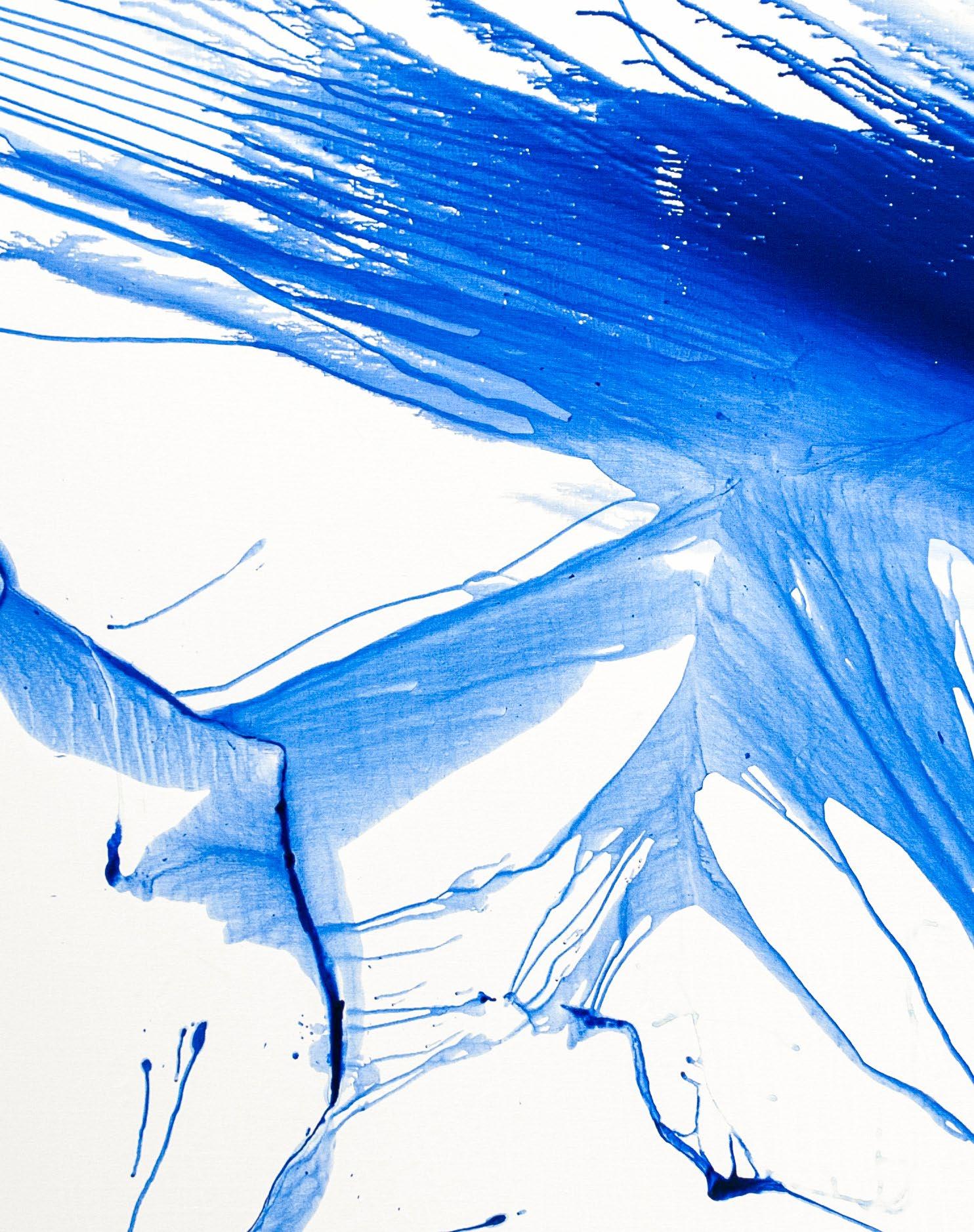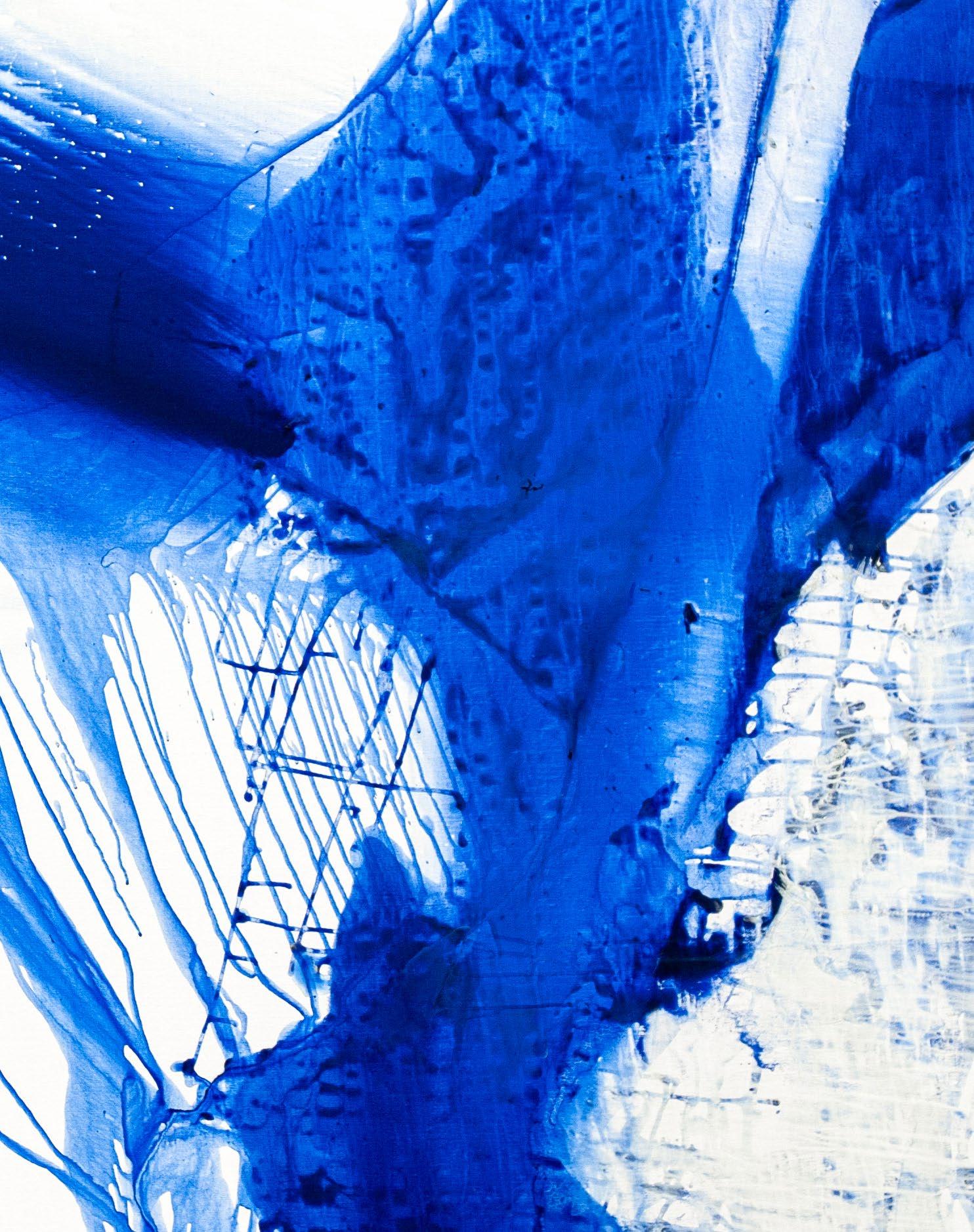

Blue me trie
Bluemetries
\ traces \ whispers
Blue me trie
\ ślady \ szepty
Bluemetrie to – etymologicznie rzecz biorąc – „odmierzanie błękitu”
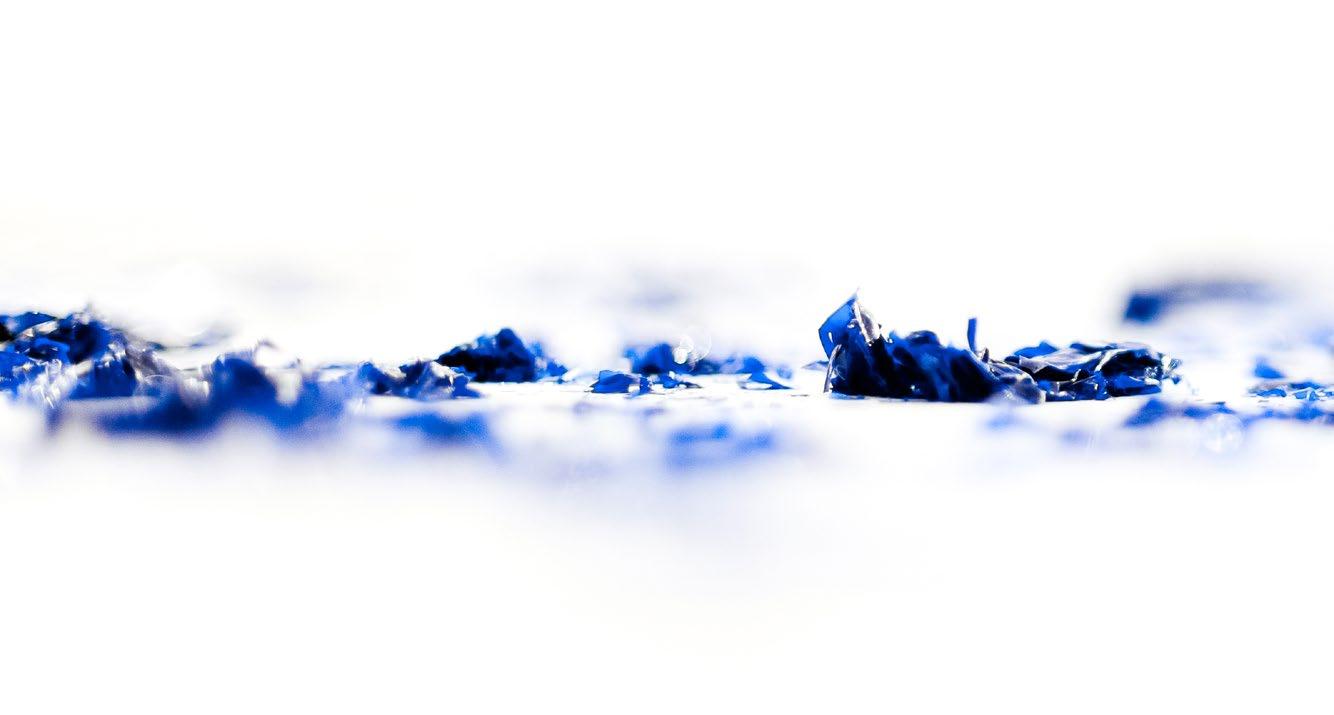
Bluemetries means – etymologically speaking – "measuring the blue"

Bluemetrie cd.
nowe prace
Urszuli Wilk Marek Śnieciński
Dociekania malarskie nad przestrzenią od dłuższego czasu stanowią niezwykle ważny wątek twórczości Urszuli Wilk. Kwestia ta jest dla artystki bardzo szczególna – przestrzeń w jej dziełach staje się czymś nieoczywistym, niejednoznacznym i zagadkowym. Stanowi dla niej problem zarówno malarski – czy, mówiąc szerzej, artystyczny – jak i jedno z podstawowych zagadnień egzystencjalnych, jedno z fundamentalnych ludzkich doświadczeń. Temat ten, który mniej lub bardziej wyraźnie przewija się w wielu realizacjach artystki, niekiedy staje się ich dominującym, kluczowy m elementem. Dzieje się tak np. w pochodzących z różnych lat pracach noszących tytuł Bluemetrie, w których ustawicznie powracają różnorodne malarskie analizy i penetracje przestrzeni.
Bluemetries cont.
new works by Urszula Wilk
Painting investigations on space have been an extremely important motif present in the artistic work of Urszula Wilk for a long time. Moreover, the issue of space is a very special one for the artist –space in her works becomes something unobvious, ambiguous and puzzling. For her, it is both a painting problem, or – to put it more broadly – an artistic problem, as well as one of the basic existential questions, one of the fundamental human experiences. This theme, which is more or less clearly present in many of the artist’s works, sometimes becomes their dominant, key element. This is the case, for example, in her works from various years called Bluemetries, in which various painterly analyses and penetrations of space constantly return.
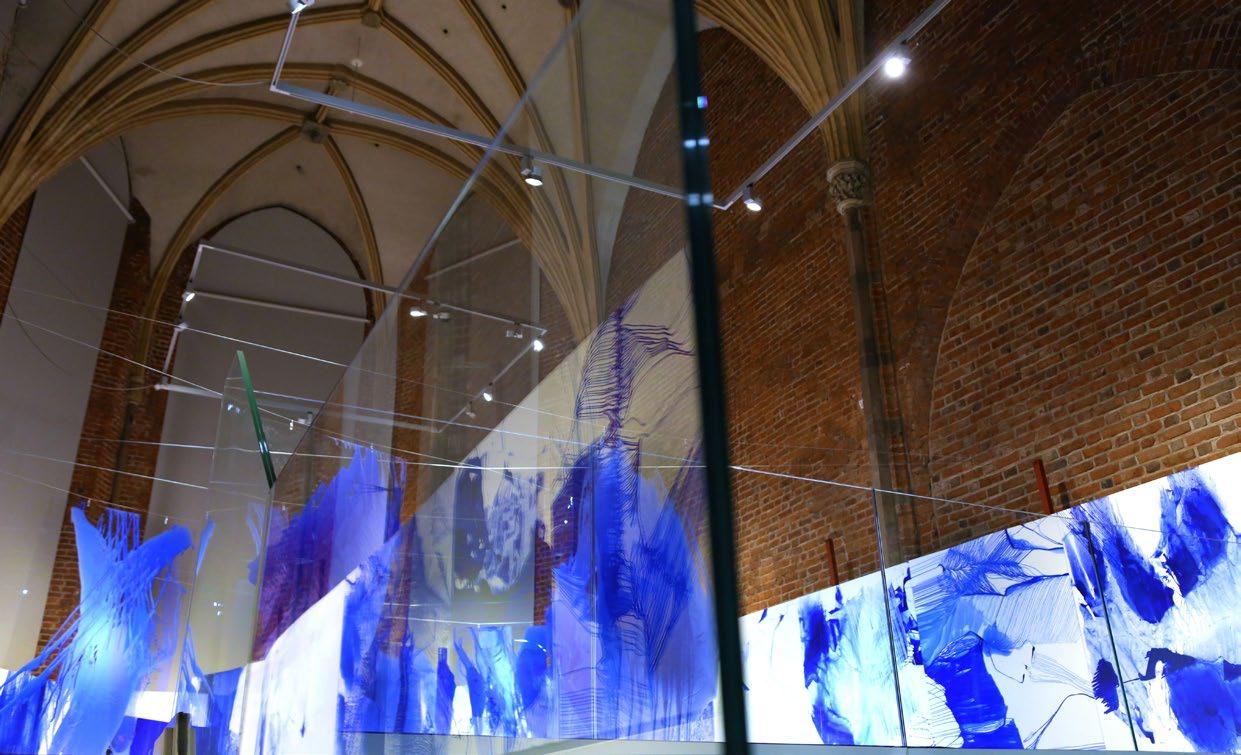

Malując \ Painting \ 2018
Muzeum Architektury we Wrocławiu \ Museum of Architecture in Wrocław
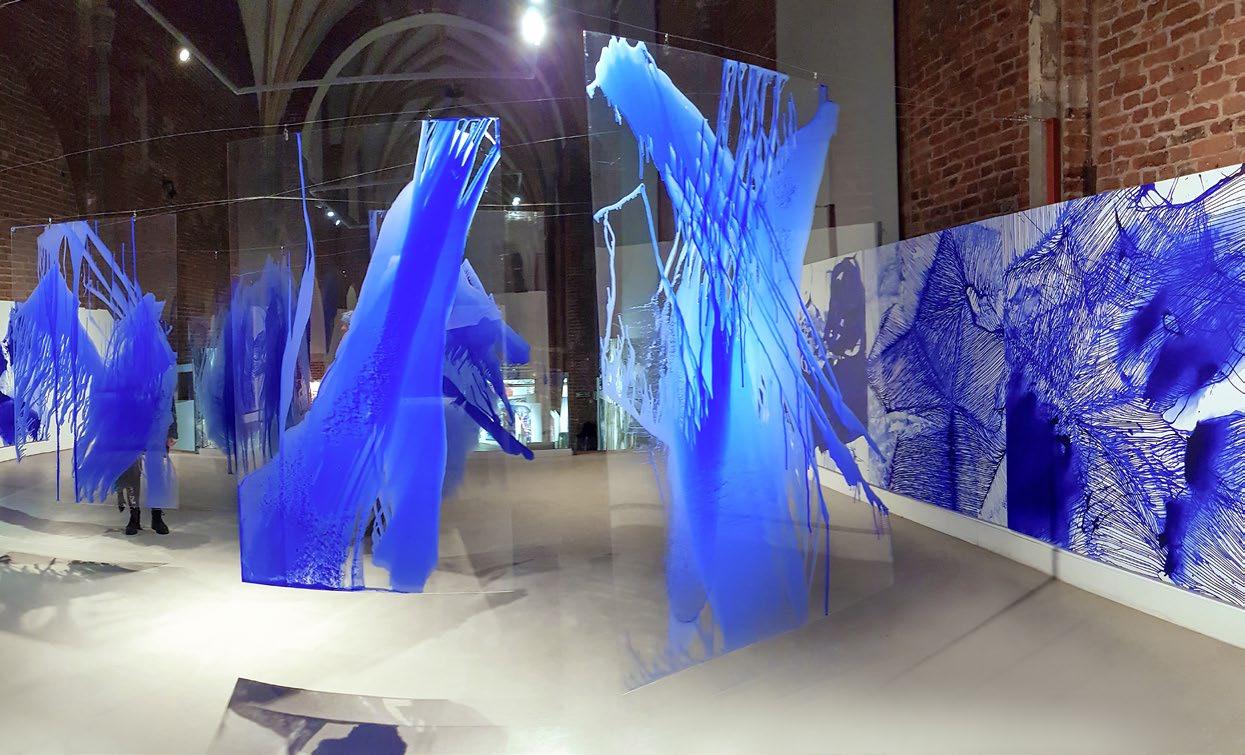
Dociekania malarskie nad przestrzenią od dłuższego czasu stanowią niezwykle ważny wątek twórczości
Urszuli Wilk
Painting investigations on space have been an extremely important motif present in the artistic work of Urszula Wilk for a long time
Bluemetrie to – etymologicznie rzecz biorąc – „odmierzanie błękitu” i takie właśnie specyficzne odmierzanie, takie zdejmowanie miary znaleźć można zarówno w obrazach Wilk wykonywanych w klasycznych technikach malarskich na tradycyjnych podobraziach, jak i w realizowanych przez artystkę malarskich instalacjach czy obiektach. Niezwykle istotny jest tutaj oczywiście fakt, że działania artystki krążą właśnie wokół błękitu, a zatem wokół barwy naznaczonej w naszej kulturze rozmaitymi kodami symbolicznymi i bogactwem znaczeń. To dziedzictwo mimowolnie przynosimy ze sobą na spotkanie z dziełami malarki, a uwarunkowane przez nie kody i symbole kulturowe będą wpływać na nasze odczytywanie jej prac.
Bluemetries means – etymologically speaking – "measuring the blue", and this specific measuring, this taking the measure, can be found both in Wilk’s paintings made in classic painting techniques on traditional supports, as well as in her painting installations and objects. What is extremely important here is the fact that the artist’s actions revolve precisely around the blue, that is a colour marked in our culture by various symbolic codes and a wealth of meanings. We unwittingly bring this heritage with us when we encounter the painter’s works, and the cultural codes and symbols they condition will influence our reading of her works.
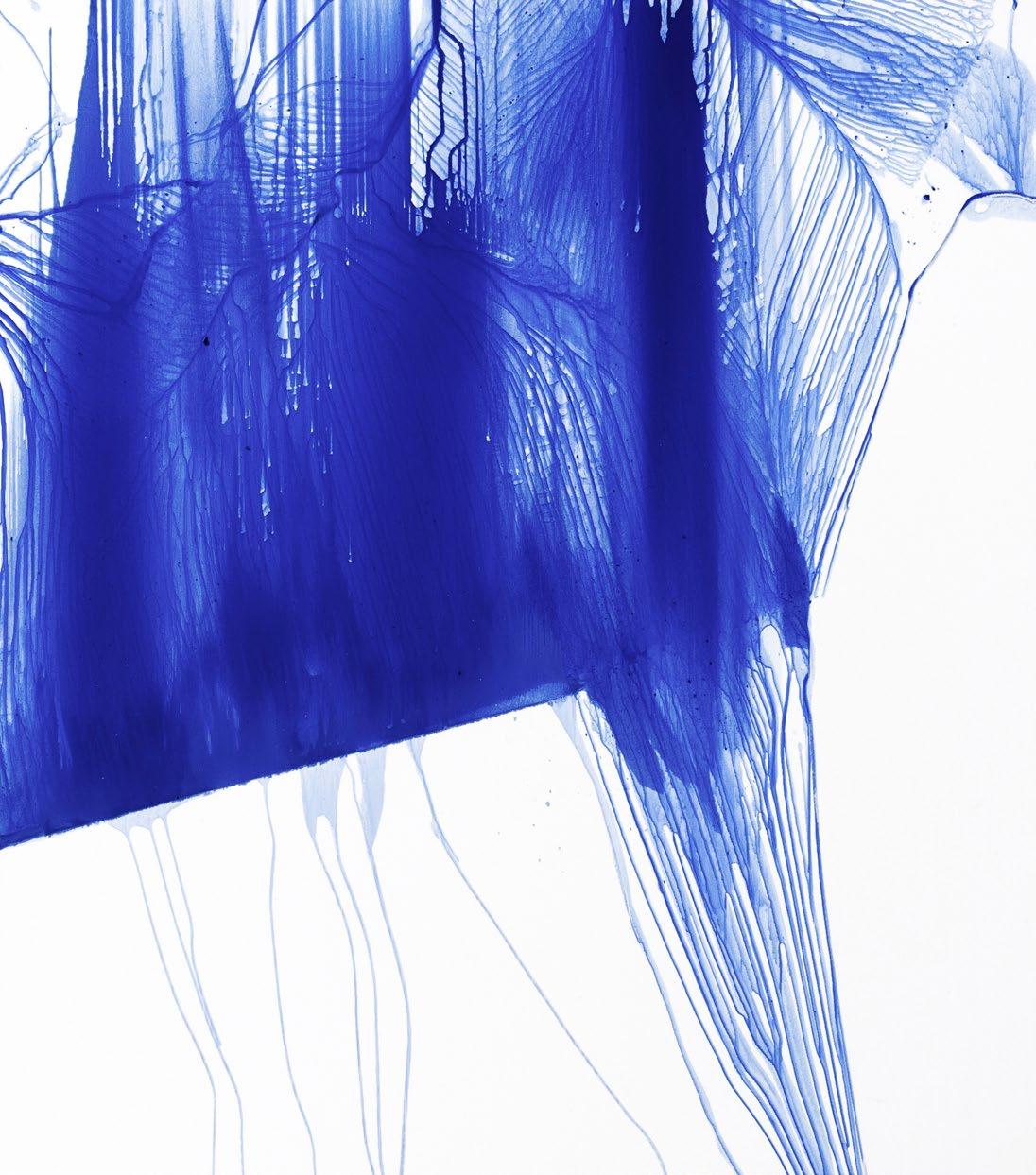
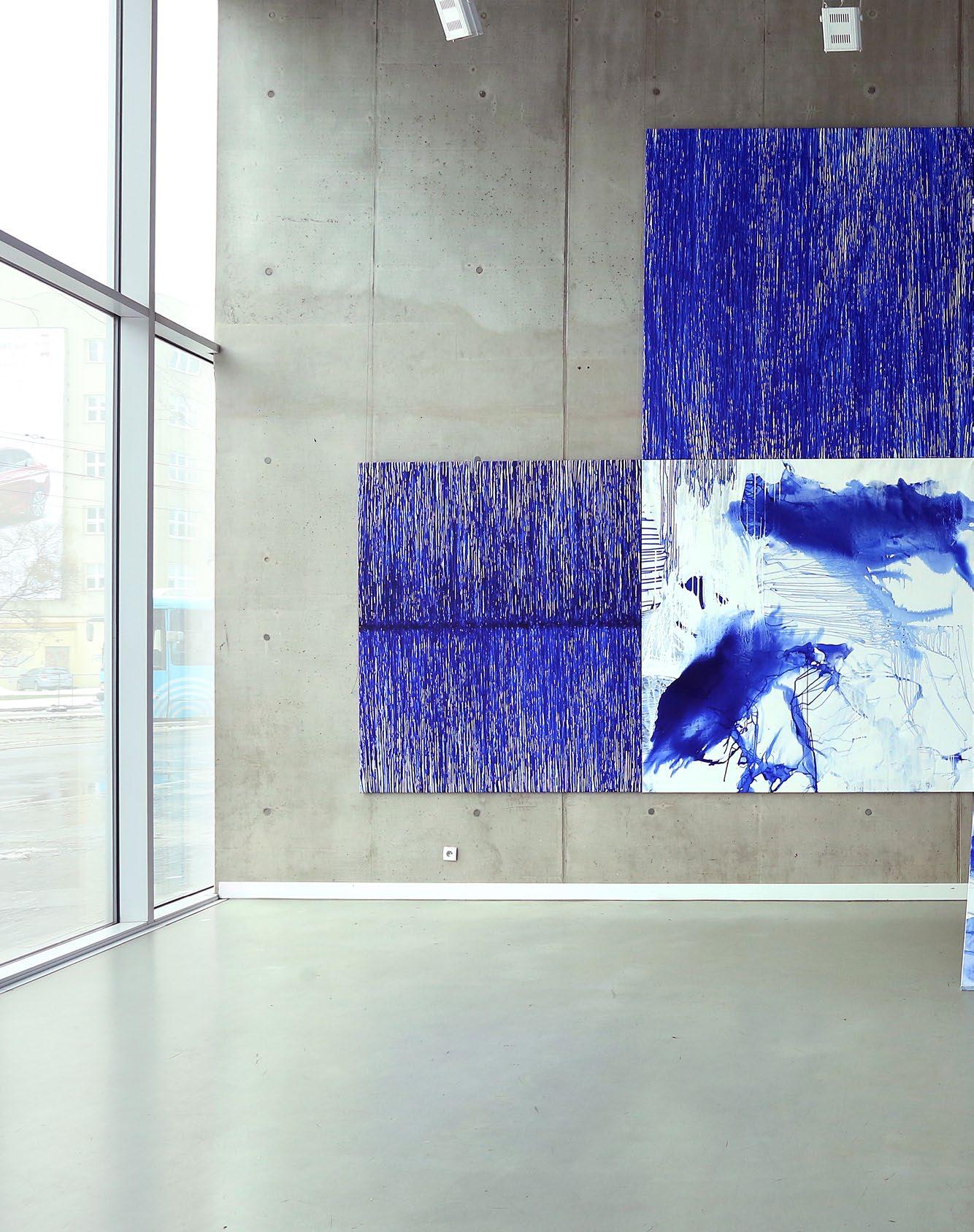
(...) przestrzeń Galerii (...) przyjęła porządek (...), którego zrytmizowana konstrukcja wyłoniła się z ujednoliconych formatów obrazów
(...) space of the Neon Gallery (...) accepted the order(...) whose rhythmical structure emerged from the uniform formats of the images
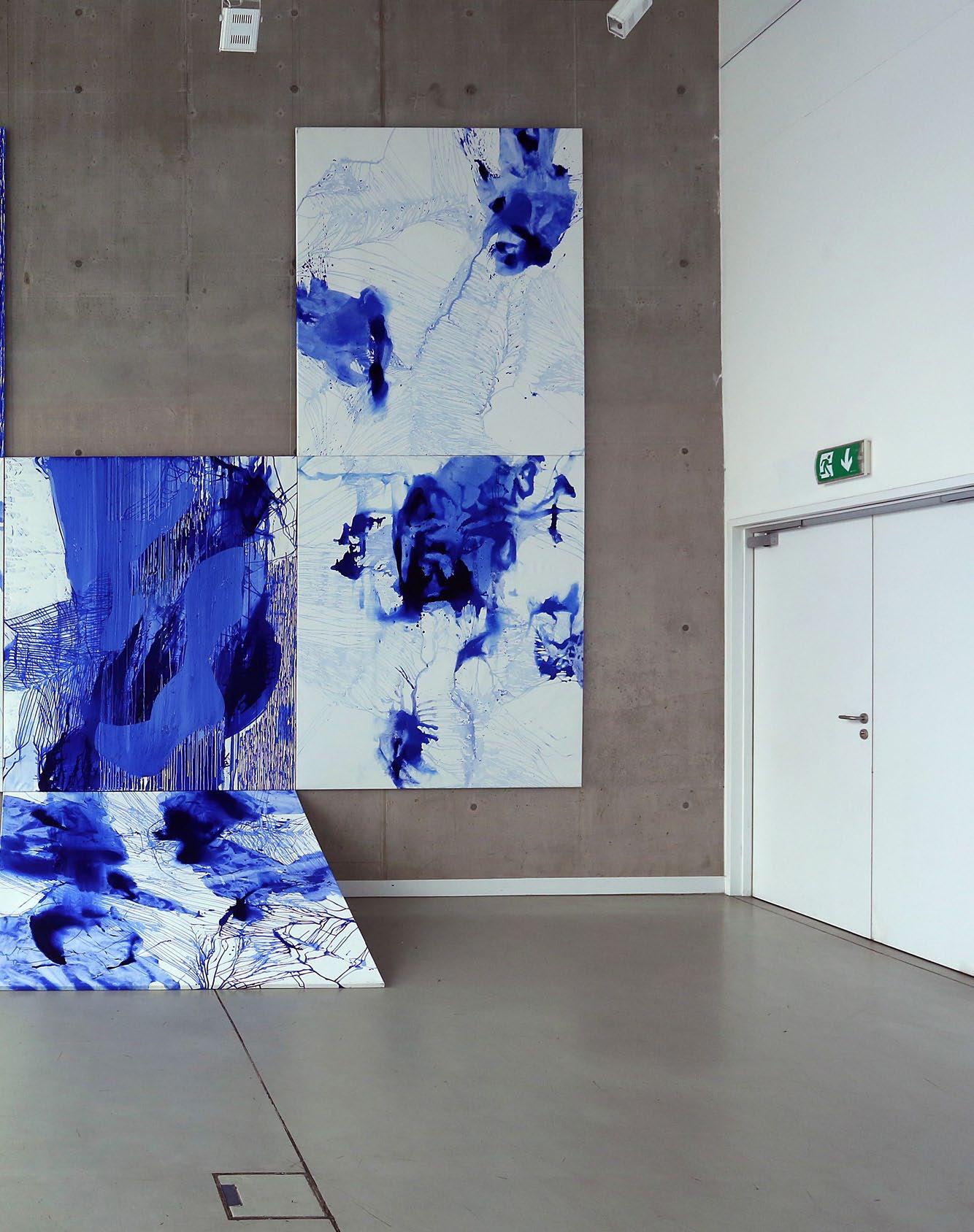
W Bluemetriach pokazanych w 2016 roku w Galerii Neon wrocławskiej Akademii Sztuk Pięknych artystka zaprezentowała oleje na płótnie z lat 2014–2016, a zestawiane ze sobą prostokąty obrazów utworzyły sporych rozmiarów strukturę malarską, rozpostartą na ścianach i posadzkach galerii. Natomiast ekspozycja we wrocławskim Muzeum Architektury w 2016 r. (wspólna z Eugeniuszem Mincielem) pomyślana została nieco inaczej, tutaj bowiem obok płócien pojawiły się także inne podobrazia, a mianowicie transparentne folie, które wypełniły przestrzeń prezbiterium dawnego klasztornego kościoła. W przypadku obu tych wystaw tytułowe „odmierzanie błękitu” było równocześnie sposobem na odpytywanie przestrzeni, w której miały funkcjonować dzieła Wilk. Przezroczysta, transparentna, pozbawiona własnych rytmów przestrzeń Galerii Neon przyjęła porządek zaproponowany przez artystkę, a był to porządek, którego zrytmizowana konstrukcja wyłoniła się z ujednoliconych formatów obrazów (200 × 175 cm) wypełnionych organicznymi, abstrakcyjnymi formami malarskimi. W Muzeum Architektury dzieła Wilk wpisały się w przestrzenne rytmy dawnego sakralnego wnętrza, które stało się swego rodzaju architektoniczną ramą i punktem odniesienia dla dzieł malarskich.
Bluemetrie \ Bluemetries \ 2018
Galeria Neon
we Wrocławiu \ Neon Gallery in Wrocław
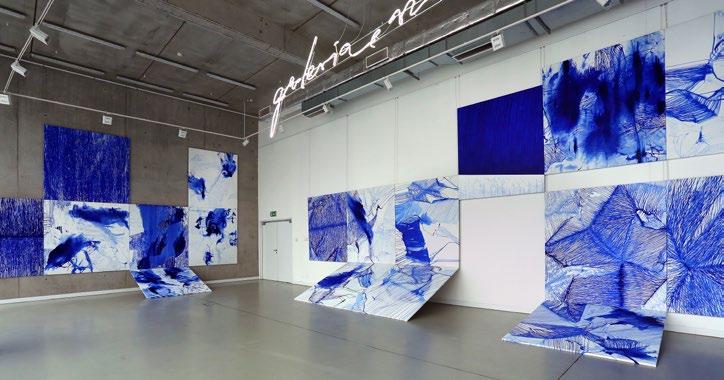
In Bluemetries, presented in 2016 at the Neon Gallery of the Wrocław Academy of Art and Design, the artist presented works (oil on canvas) from 2014–16, where juxtaposed rectangles of paintings formed a sizable painterly structure spread across the walls and floors of the gallery. By contrast, the presentation at the Wrocław Museum of Architecture in 2016 (a joint exhibition with Eugeniusz Minciel) was conceived in a slightly different way, since here, next to the canvases, other supports appeared, namely transparent foils that filled the space of the chancel of the former monastery church. In the case of both these exhibitions, the title “measuring the blue” was at the same time a way of questioning the space in which Wilk’s works were to function. The transparent space of the Neon Gallery, without its own rhythms, accepted the order proposed by the artist, an order whose rhythmical structure emerged from the uniform formats of the images (200 × 175 cm) filled with organic, abstract painting forms. In the Museum of Architecture, the artist’s works were inserted into the spatial rhythms of the old ecclesiastical interior, which became a kind of architectural frame and point of reference for the paintings.

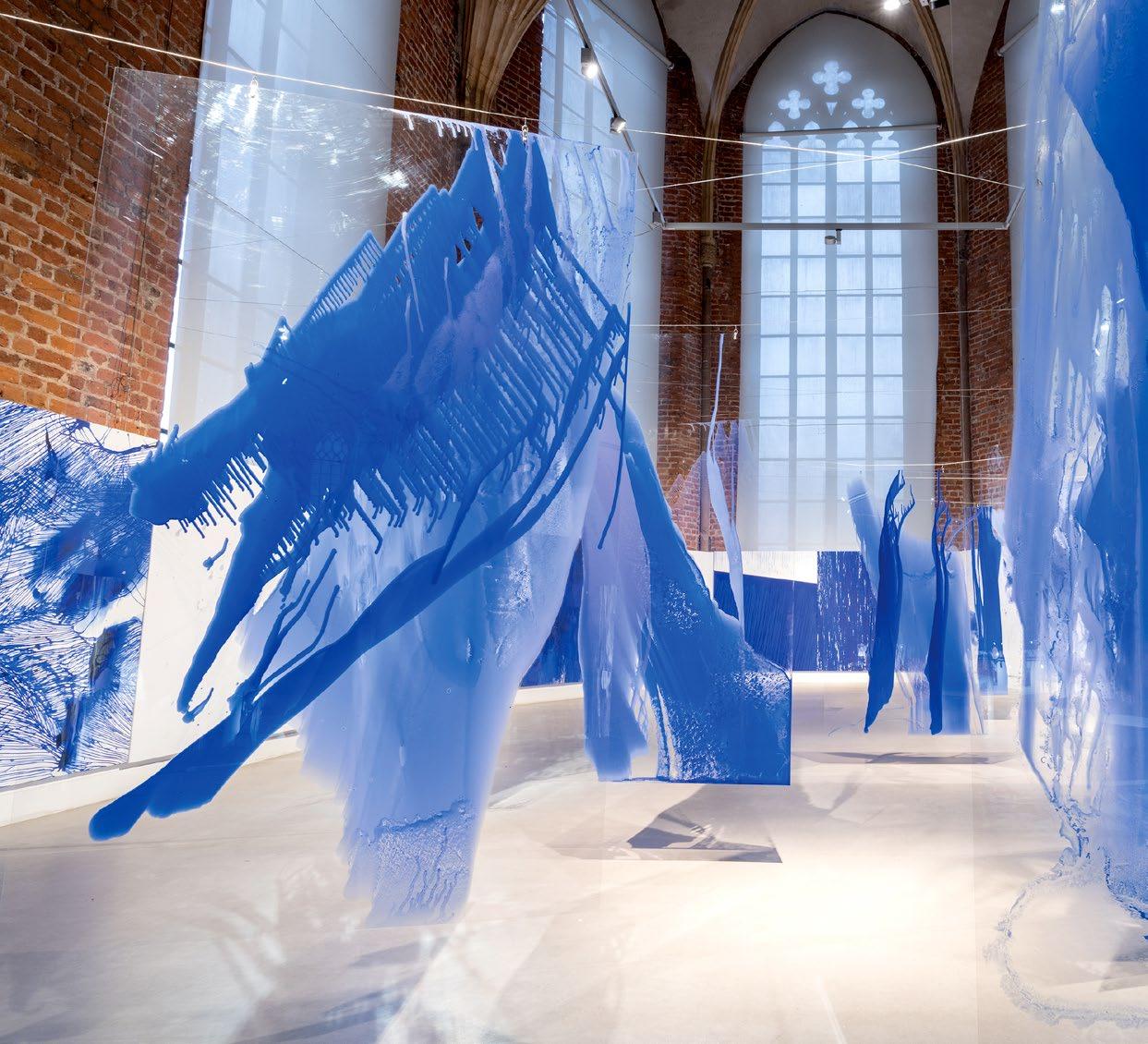
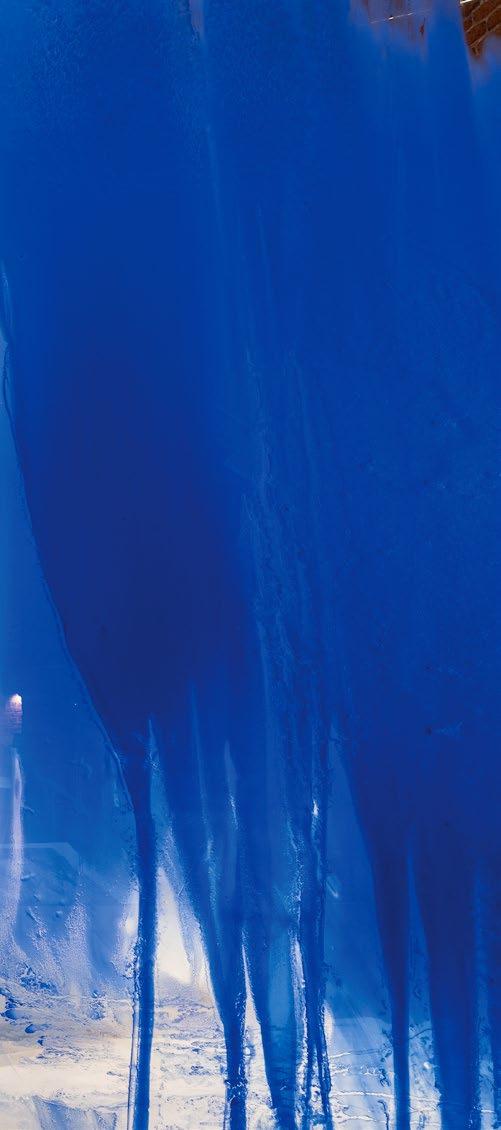
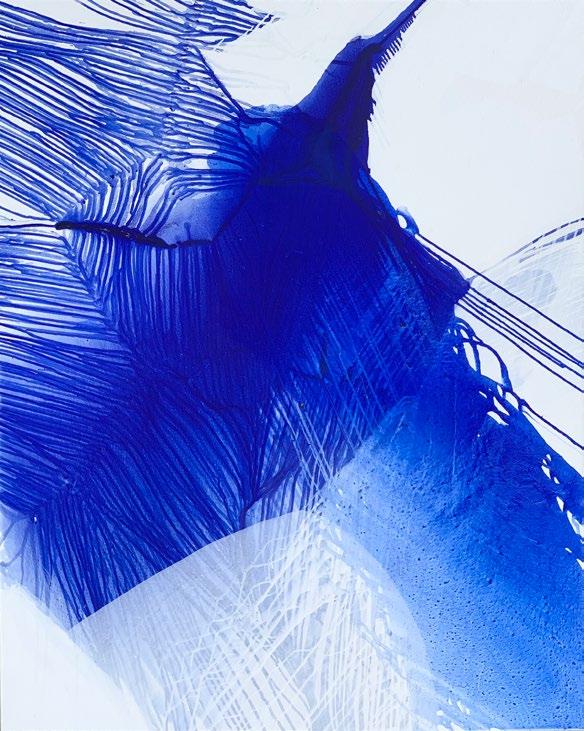
Bluemetrie nr 4 \ Bluemetries No. 4 \ 2022–23
akryl, olej, werniks na płótnie \ acrylic, oil, varnish on canvas \ 120 × 150 cm
← Malując \ Painting \ 2018 Muzeum Architektury we Wrocławiu \ Museum of Architecture in Wrocław
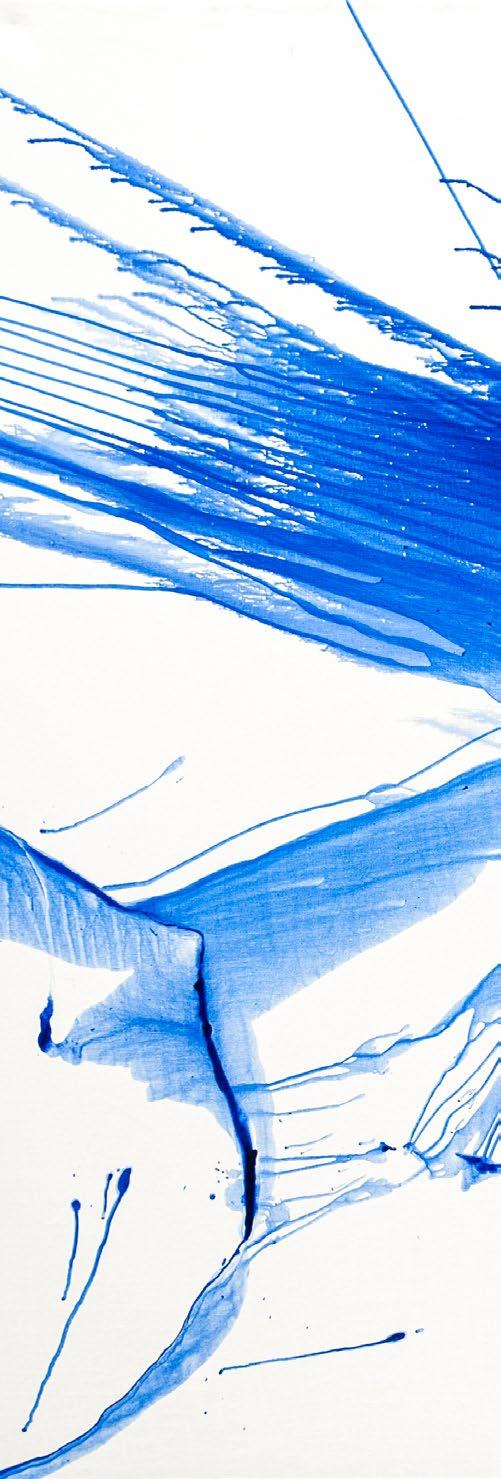
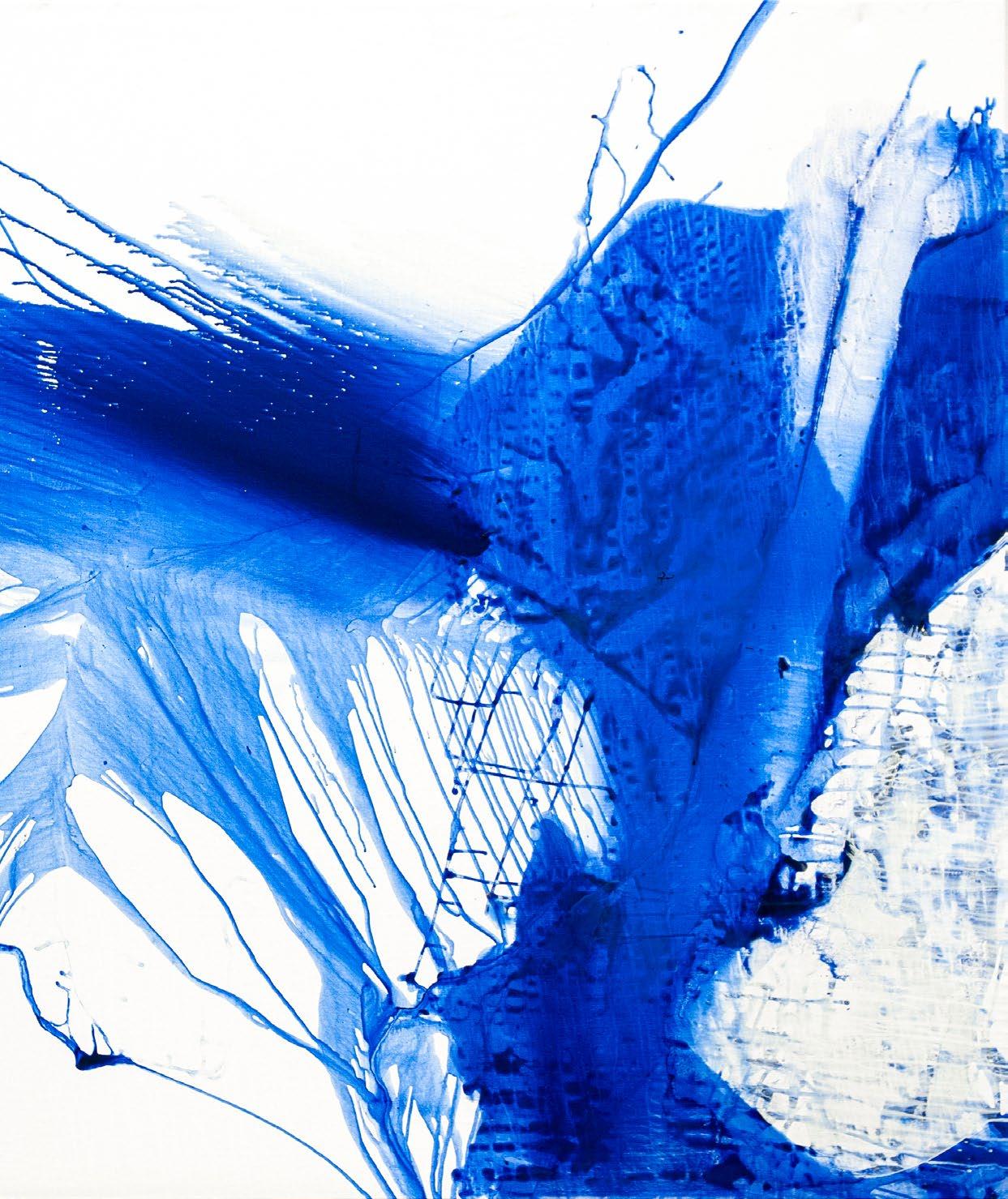
Zagadnienia związane z kwestią przestrzeni, ze sposobami i formami jej doświadczania, stały się również najistotniejszym wyzwaniem artystycznym, z jakim twórczyni musiała zmierzyć się w swej najnowszej realizacji. Pojawiła się ona w elbląskiej Galerii El, która nawiasem mówiąc, podobnie jak Muzeum Architektury we Wrocławiu, zdaje się dysponować wnętrzem wyjątkowo stosownym do artystycznych (także malarskich) analiz przestrzeni. Funkcjonując w dawnej gotyckiej świątyni, ma wyrazisty, niepowtarzalny charakter, definiowany przez wysokość i rozległość surowych sklepionych wnętrz, przez architektoniczne rytmy i zrytmizowane struktury ceglanych wątków ścian.
Jest to zatem przestrzeń obdarzona podmiotową tożsamością, a nie jedno z typowych współczesnych miejsc wystawienniczych, które bywają najczęściej anonimowe i transparentne. Owej podmiotowości nie można zlekceważyć – trzeba się do niej odnieść, trzeba nawiązać z nią dialog (choćby polemiczny), trzeba zobaczyć i usłyszeć jej zrytmizowaną opowieść.
Wpisana we wnętrza Galerii El najnowsza realizacja malarska Wilk jest dziełem szczególnego rodzaju. To kolejna odsłona Bluemetrii, jednak tym razem mamy do czynienia z instalacją, w której poszczególne elementy składają się na rozbudowaną przestrzenną strukturę, przy czym rozpiętość owej struktury i jej wielowymiarowość sprawiają, że dzieła tego nie da się ogarnąć jednym „rzutem” oka, nie da się w jednej chwili przemierzyć go spojrzeniem.
The issues related to the question of space, ways and forms of experiencing it, have also become the most significant artistic challenge the artist had to face in her latest work, which appeared in El Gallery in Elbląg. By the way, El Gallery, just like the Museum of Architecture in Wrocław, seems to have an interior particularly well suited for artistic (including painting) analyses of space. The gallery, which functions in a former gothic temple, has a distinct, unique character, defined by the height and extent of its austere vaulted interiors, architectural rhythms and rhythmic structures of the brick wall motifs. It is therefore a space endowed with a subjective identity and not one of the typical contemporary exhibition places, whose spaces tend to be anonymous and transparent. This subjectivity cannot be ignored, one has to refer to it, one has to enter into a dialogue with it (even a polemical one), one has to see and hear its rhytmic story.
Inscribed in the interiors of the El Gallery, Wilk’ latest painting implementation is a work of a special kind. It is a yet another version of Bluemetries, however, this time we are dealing with an installation in which individual ele ments make up an elaborate spatial structure, yet the span of this structure and its multidimensionality make it impossible to grasp this work with a single glance.
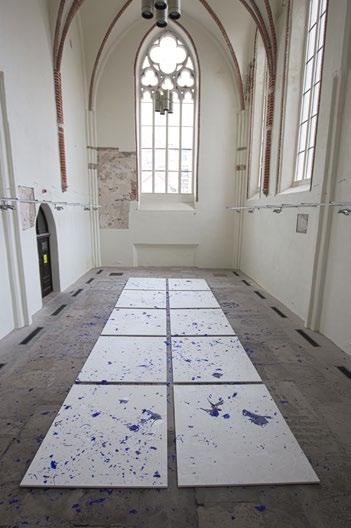
Bluemetrie \ Bluemetries \ 2021
Galeria El w Elblągu \ El Gallery in Elbląg
→ Bluemetrie \ Bluemetries \ 2021
Galeria El w Elblągu \ El Gallery in Elbląg
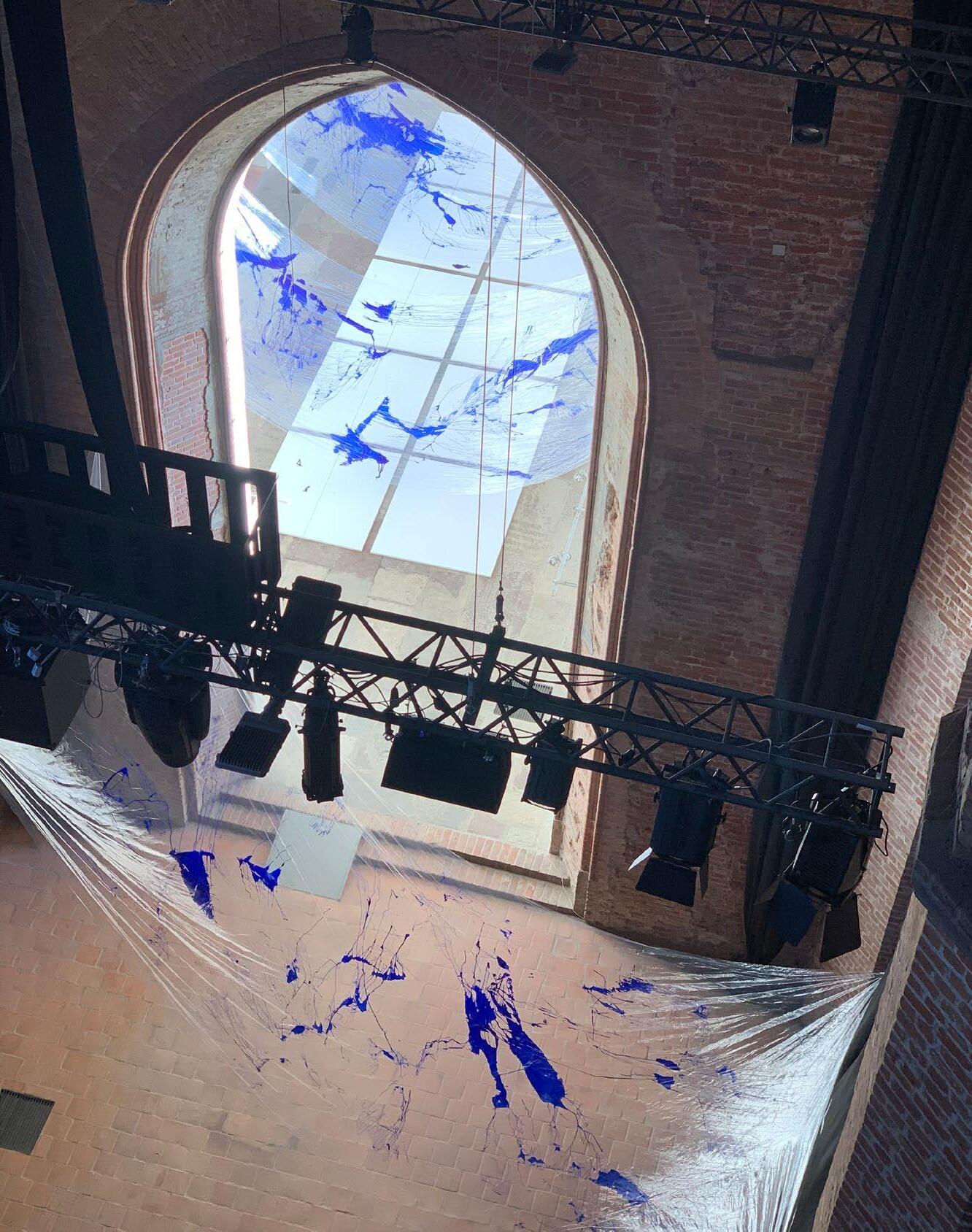
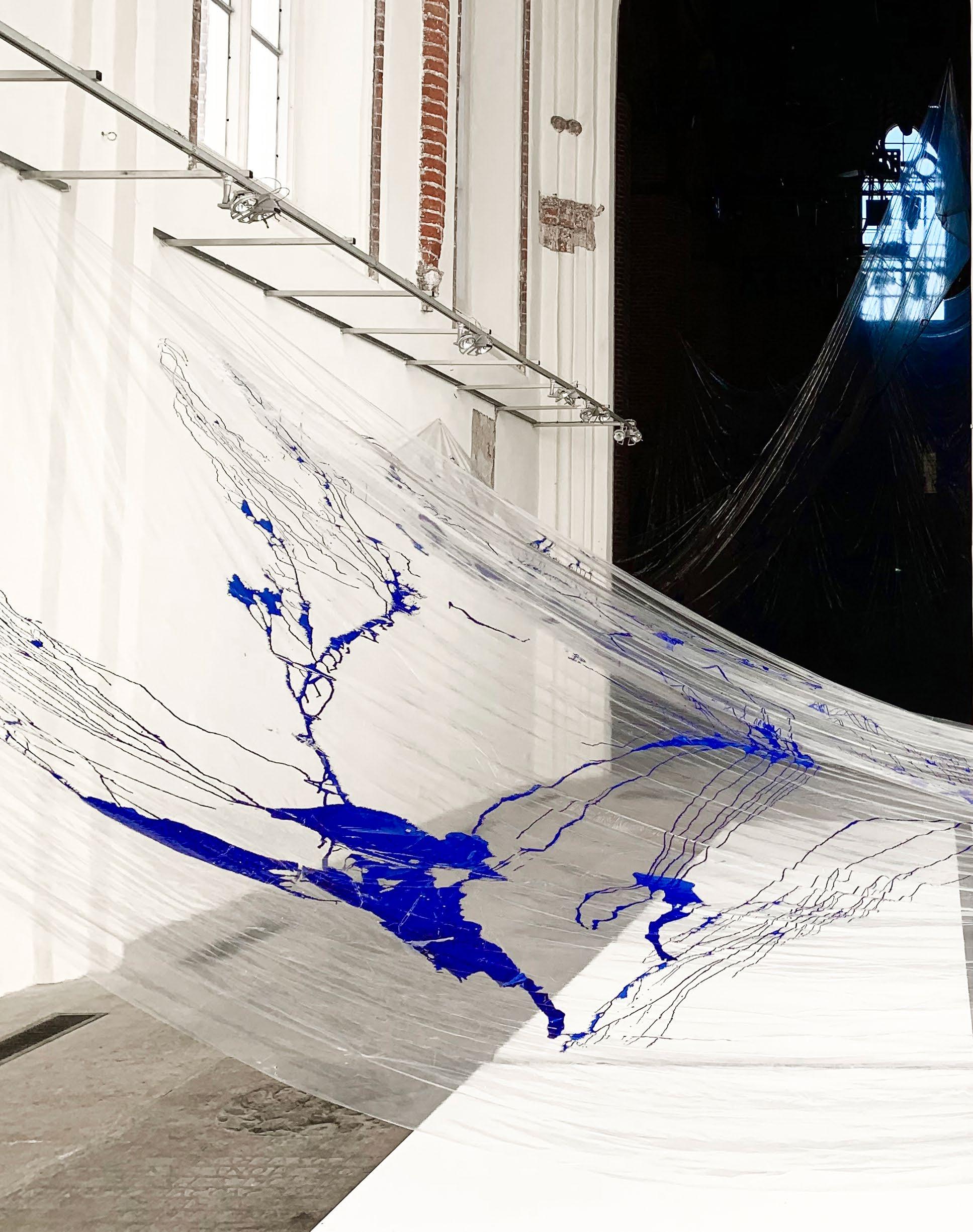
(...) artystka podkreśla, że Bluemetrie wiążą się z jej zainteresowaniem „niematerialną strukturą przestrzeni, jej gęstością”➀
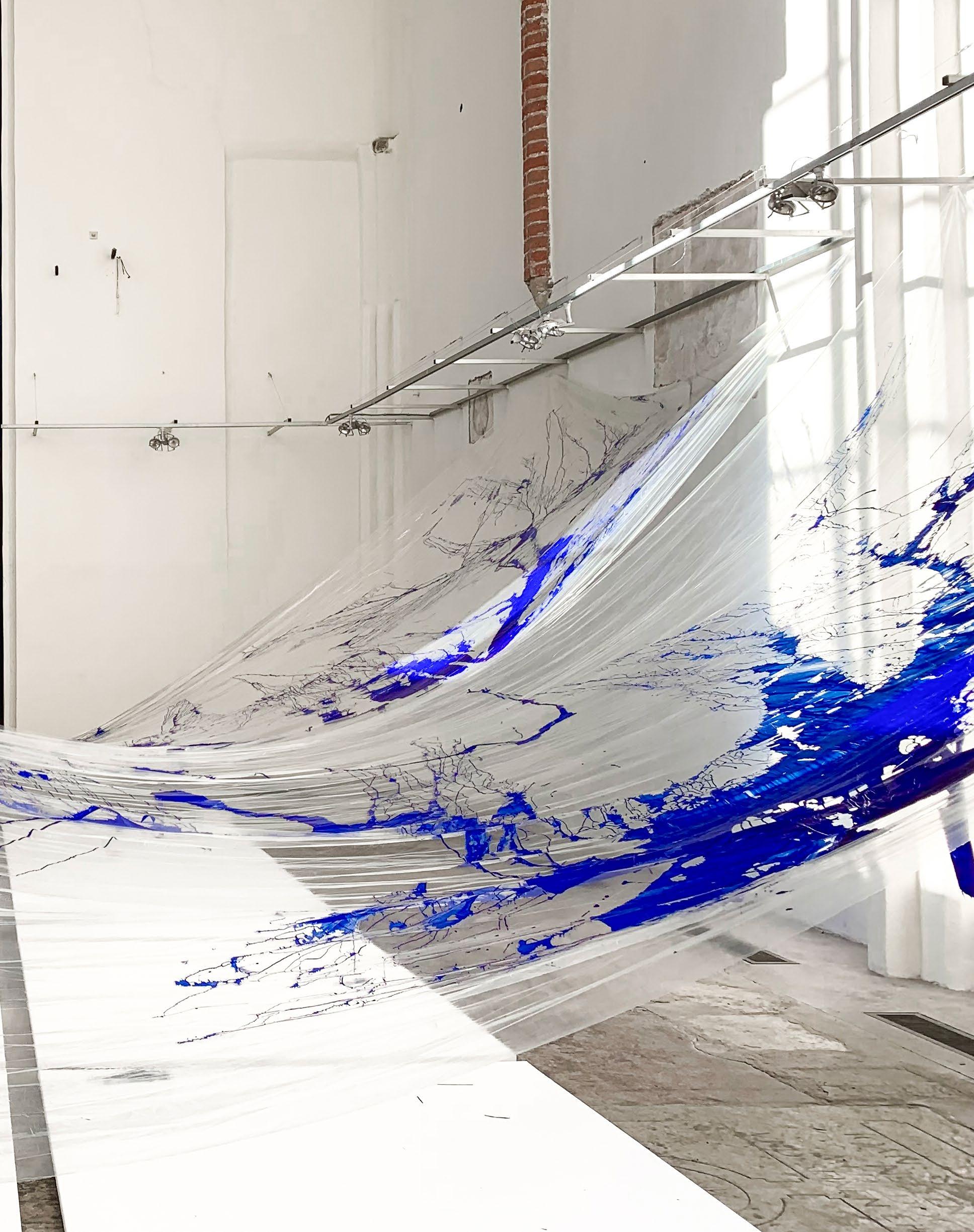
In her commentary, the artist stresses that Bluemetrie s are connected with her interest in the “immaterial structure of space, its density ”.➀
➀ U. Wilk \niepublikowana wypowiedź o koncepcji wystawy w Galerii El \ styczeń 2021
Unpublished statement on the concept of the exhibition at the El Gallery \ January 2021
➁ Ibidem.
Ibidem.
W odautorskim komentarzu artystka podkreśla, że Bluemetrie wiążą się z jej zainteresowaniem „niematerialną strukturą przestrzeni, jej gęstością”➀. „Niematerialna gęstość przestrzeni” – w określeniu tym zawarte jest wyzwanie, przed jakim stanęła Wilk. Nie chce nam tutaj bowiem zaproponować pewnej metafory malarskiej, lecz chce zmierzyć się z ową „gęstością”, chce, żeby widzowie sami mogli jej doświadczyć, by owa gęstość stała się dla nich pewnym faktem. Artystka pojmuje swe dzieło jako „rodzaj dialogu z wszechogarniającym nas chaosem/porządkiem tego, co fizyczne i bezpośrednie, z tym, co jest po przeciwnej stronie materialnego postrzegania rzeczywistości”➁. Odbiór dzieła staje się tutaj rodzajem dosłownej wędrówki w przestrzeni instalacji – wędrówki, której etapy i rytmy muszą określić sami widzowie. Po pierwsze, wiąże się to z użytymi przez artystkę materiałami i rozmiarem tej instalacji, zbudowanej z opracowanych malarsko 30 brytów transparentnej folii, z których każdy ma szerokość 4 m i długość 12 m.
In her commentary, the artist stresses that Bluemetrie s are connected with her interest in the “immaterial structure of space, its density ”.➀ The immaterial density of space – in this term is contained the challenge which the painter faced. U. Wilk does not want to offer us here a certain painting metaphor, but she wants to confront this “density”, she wants the viewers to be able to experience it themselves, so that this density becomes a cer tain fact for them. The artist perceives her work as “a kind of dialogue with the overwhelming chaos/order of what is physical and direct, with what is on the opposite side of the material perception of reality”. ➁ The reception of the work becomes here a kind of literal wandering in the space of the installation, a wandering whose stages and rhythms must be determined by the viewers themselves. Firstly, it results from the materials used by the artist and the size of the installation composed of thirty panels of transparent foil, each of them 4 m wide and 12 m long.
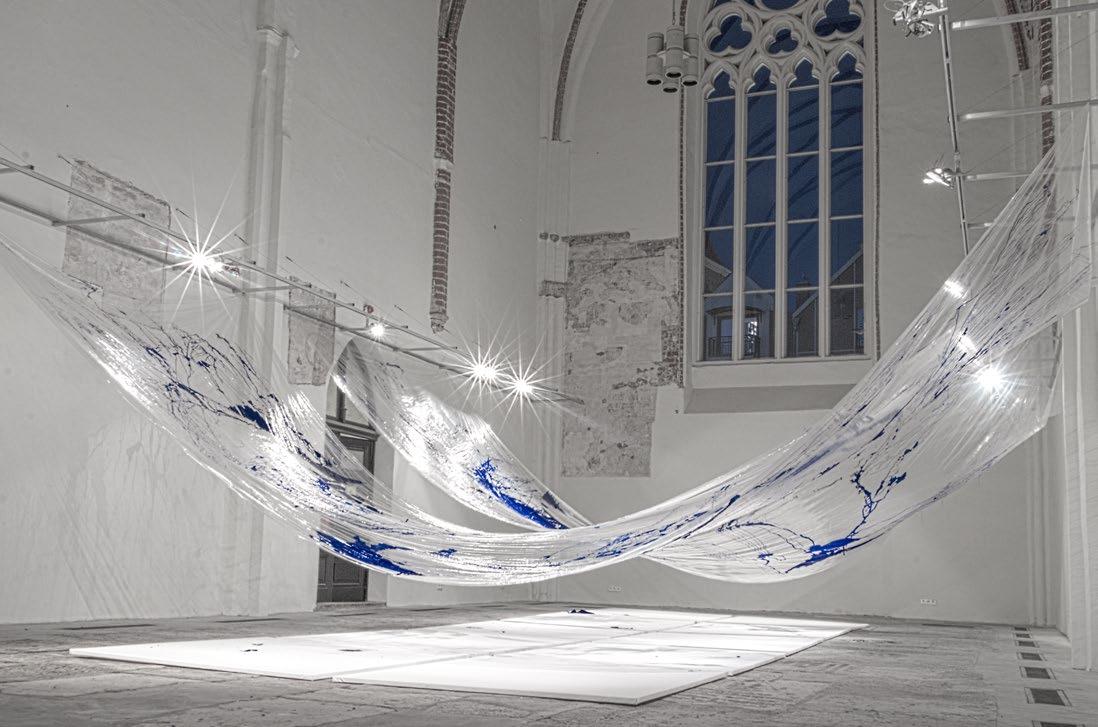
Bluemetrie \ Bluemetries \ 2021
Galeria El w Elblągu \ El Gallery in Elbląg
Po drugie, artystka nie wyznacza tu jednej perspektywy, z której odbiorca powinien oglądać instalację, nie określa też punktu, od którego należałoby rozpocząć wędrówkę i zacząć odczytywać dzieło, nie wyznacza również kierunków i rytmów poruszania się widzów w przestrzennej strukturze dzieła. Po trzecie, niezwykle ważną właściwość charakterystyczną dla owej instalacji stanowi niestabilność podobrazia, niestabilność i wiotkość materii, na której zapisane zostały gesty malarskie artystki. Ta niestabilność doświadczana jest również przez widzów, staje się bowiem istotnym elementem percepcyjnego dialogu z dziełem – bryty folii wchodzą w interakcję z pojawiającymi się osobami, reagują na fizyczną obecność odbiorców i odpowiadają swoimi delikatnymi poruszeniami na ruch człowieka. Można powiedzieć, że owa instalacja nie tylko komunikuje się z ludzkim wzrokiem, lecz że wchodzi w kontakt i nawiązuje rozmowę również z naszym oddechem.
Secondly, the artist does not indicate a single perspective from which the viewer should watch the installation, nor does she specify the point from which one should start the journey and start reading the work, nor does she indicate the directions and rhythms of the visitors’ movement within the spatial structure of the work. Thirdly, an extremely important charac teristic of this installation is the instability of the support, the instability and limpness of the matter on which the artist’s painting gestures were recorded. This instability is also experienced by the viewers, as it becomes an important element of the perceptual dialogue with the work – the panels of the foils interact with the persons appearing, react to the physical presence of the spectators and respond with their delicate movements to human movement. It can be said that this installation communicates not only with the human eye, but that it also comes into contact and establishes a conversation with our breath.
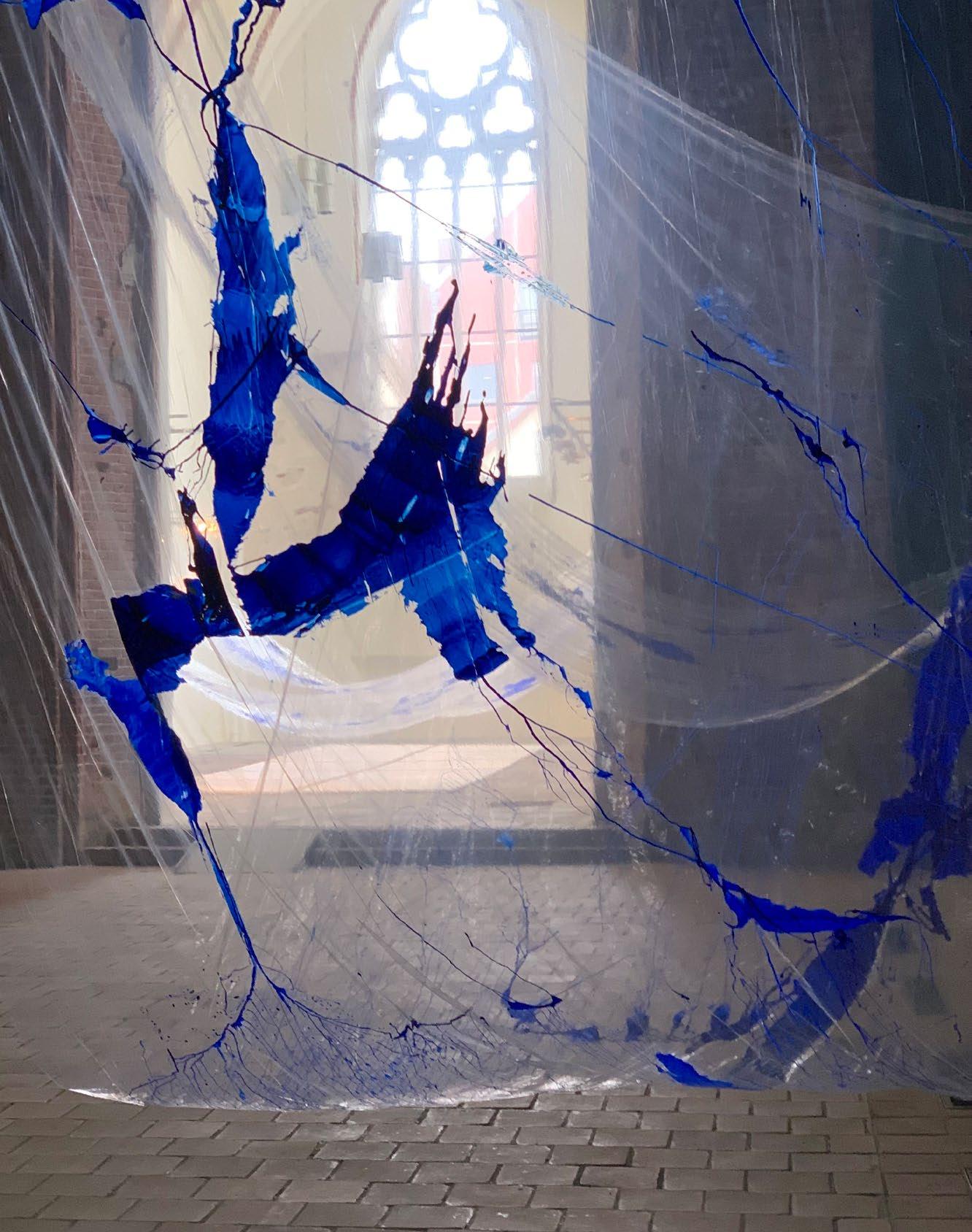
← Bluemetrie \ Bluemetries \ 2021
Galeria El w Elblągu \ El Gallery in Elbląg
Bluemetrie \ Bluemetries \ 2021
→ Galeria El w Elblągu \ El Gallery in Elbląg
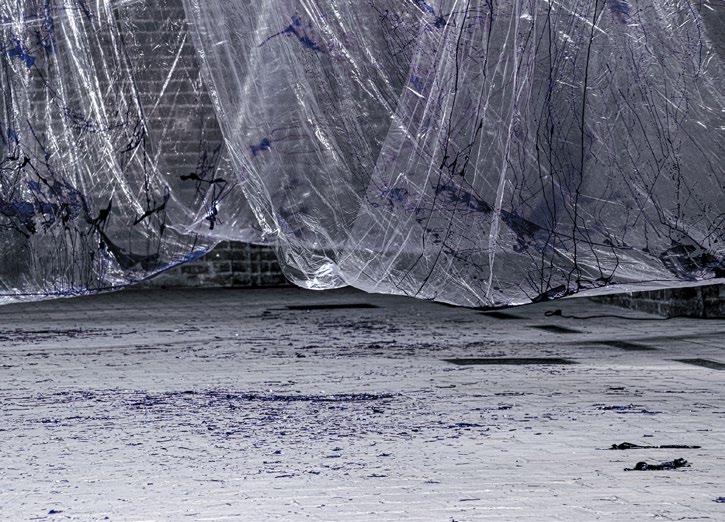
W elbląskie Bluemetrie cd. wpisana jest specyficzna zmienność i efemeryczność – przestrzenne, transparentne obrazy jawią się tutaj jako pewne środowisko, jako efemeryczny przestrzenny byt, w jakim można się zanurzyć. Instalacja ta, choć oczywiście materialna i precyzyjnie skonstruowana, uzyskuje status zjawiska, które dopiero za sprawą aktywnej obecności człowieka zaczyna przybierać właściwą formę, staje się przestrzennym wydarzeniem. Wilk podkreśla:
wybór materiałów […] nie był przypadkowy. Wybrałam folie i farby wodne, właściwie absolutnie wbrew technologii malarskiej, połączenie tych dwóch mediów jest właściwie niemożliwe. Chciałam podkreślić ulotność i efemeryczność działań, a jednocześnie ciągłą transformację i niestabilność materii ➂.
Bluemetrie stanowią dzieło, które jest „jednocześnie w trakcie powstawania i rozpadania, konstrukcji i dekonstrukcji” ➃. Owa procesualność daje o sobie znać nie tylko za sprawą percepcyjnych doznań związanych z wiotkością i niestabilnością użytego podobrazia.
In the Elbląg Bluemetries there is a specific changeability and ephemerality inscribed in them – spatial, transparent images appear here as a certain environment, as an ephemeral spatial entity in which one can immerse one self. This installation, although obviously material and precisely constructed, acquires the status of a phenomenon which only thanks to the active presence of a human begins to take its proper form, becoming a spatial event. Wilk emphasises that
the choice of materials […] was not accidental. I chose foils and water paints, in fact, absolutely against the technology of painting, the combination of these two media is virtually impossible. I wanted to emphasise the transience and ephemerality of actions and, at the same time, the constant transfor mation and instability of matter. ➂
Bluemetries are a work that is “simultaneously in the process of creation and disintegration, construction and deconstruction”. ➃ This processualism of the work is evident not only through the perceptual experience of the limpness and instability of the supports used.
➄
W. Welsch, Estetyka poza estetyką. O nową postać estetyki \ przeł. K. Guczalska, red. nauk. K. Wilkoszewska \ Kraków 2005 \ s. 163.
W. Welsch, Estetyka poza estetyką \ transl. K. Guczalska, Sc. Ed. K. Wilkoszewska \ Kraków 2005 \ p. 163.
➅ Ibidem.
Ibidem.
Pod brytami folii, na posadzce artystka ułożyła szereg białych, czystych podobrazi, na których – właściwie natychmiast po zamontowaniu instalacji – zaczęła gromadzić się osypująca się z folii błękitna farba. Elbląska realizacja była zatem zarazem odmierzaniem błękitu i odmierzaniem czasu. „Gęstość przestrzeni”, która tak bardzo zajmuje artystkę, podlegała tutaj uczasowieniu – i właśnie tylko dzięki temu, że przeistoczyła się w czasoprzestrzeń, można było doświadczyć jej malarskiej gęstości. Specyfika instalacji Wilk sprawia, że w pewnym sensie zakwestionowany w niej zostaje charakterystyczny dla zachodniej logiki estetycznej podmiotowoprzedmiotowy schemat wpisywany w dzieła sztuki i ich kontemplację. Wolfgang Welsch, który poświęca tym kwestiom sporo uwagi, analizuje je w kontekście takich wzorców kulturowych, jak opozycyjny lub symbiotyczny stosunek podmiotu do świata. Welsch uważa, że:
Under the coils of foil, on the floor, the artist placed a number of clean, white supports on which – practically immediate ly after the installation –blue paint began to accumulate, falling down from the foil. Thus, the Elbląg implementation was both the measurement of blue and the measurement of time. The density of space, which concerns the artist so much, was subjected here to temporalization – and it was only thanks to the fact that it transformed into space time that one could experience its painting density. The specificity of Wilk’s installation causes it to question, in a way, the subject object pat tern, characteristic of the Western aesthetic logic, which is inscribed in works of art and their contemplation. Wolfgang Welsch, who devotes considerable attention to these issues, analyses them in the context of such cultural norms as the subject’s oppositional or symbiotic relation to the world. Welsch maintains that:
przejście od relacji podmiotu i przedmiotu do relacji przynależności nie może zostać przedstawione. Bowiem poprzez odbiór, najpóźniej wtedy, przedstawienie pada ofiarą podmiotowo-przedmiotowego schematu ➄ the transition from a relation of subject and object to a relation of belonging cannot be represented. For through reception, at the latest, the representation falls prey to the subject-object schema. ➄
Niemiecki filozof sądzi, że „przejście od opozycyjnego do symbiotycznego stosunku wobec świata może objawić się w obrazie jedynie za pośrednictwem zdarzenia” ➅. W przypadku malarskiej instalacji Wilk nie chodzi jedynie o symbiotyczny stosunek dzieła do świata (np. do zastanej przestrzeni), lecz o to, że samo dzieło i zanurzonych w nim ludzi łączy symbiotyczny związek, że razem stanowią oni pewien fakt życiowy. Instalacja artystki nie chce tylko Instalacja artystki nie chce tylko czegoś znaczyć, nie chce być w pewien szczególny sposób odczytywana, kontemplowana czy interpretowana.
Welsch believes that “the transition from an oppositional to a symbiotic relation to the world can only manifest itself in a painting through an event ”. ➅ In the case of Wilk’s painting installation, it is not only about the symbiotic re lation of the work to the world (e.g. to a given space), but about the fact that the work itself and the people immersed in it share a symbiotic relationship, that together they constitute a certain fact of life. The artist’s installation does not only want to mean something, it does not want to be read, contemplated or interpreted in a particular way.
\ 2021
Dzieło to chce być faktem, wydarzeniem, chce być czymś. Niewykluczone, iż właśnie w ten sposób realizuje się tutaj ów postulowany przez Hansa Georga Gadamera jakościowy, ontologiczny skok związany z dziełem sztuki, który polega na tym, że „dzieło sztuki nie tylko odsyła do czegoś, ale że w nim właściwie tu oto jest to, na co się wskazuje. Innymi słowy: dzieło sztuki oznacza pewien przyrost bytu” ➆. Wiele przesłanek sugeruje, że instalacja Bluemetrie cd. może stanowić doskonałą odpowiedź na pytanie, jak w dziele sztuki ów przyrost bytu ma szansę się dokonać. To odpowiedź, która wymyka się rozmaitym dyskursom teoretycznym, w tym także hermeneutycznym, natomiast pojawia się przed widzami jako pewnego rodzaju elementarne ludzkie doświadczenie.
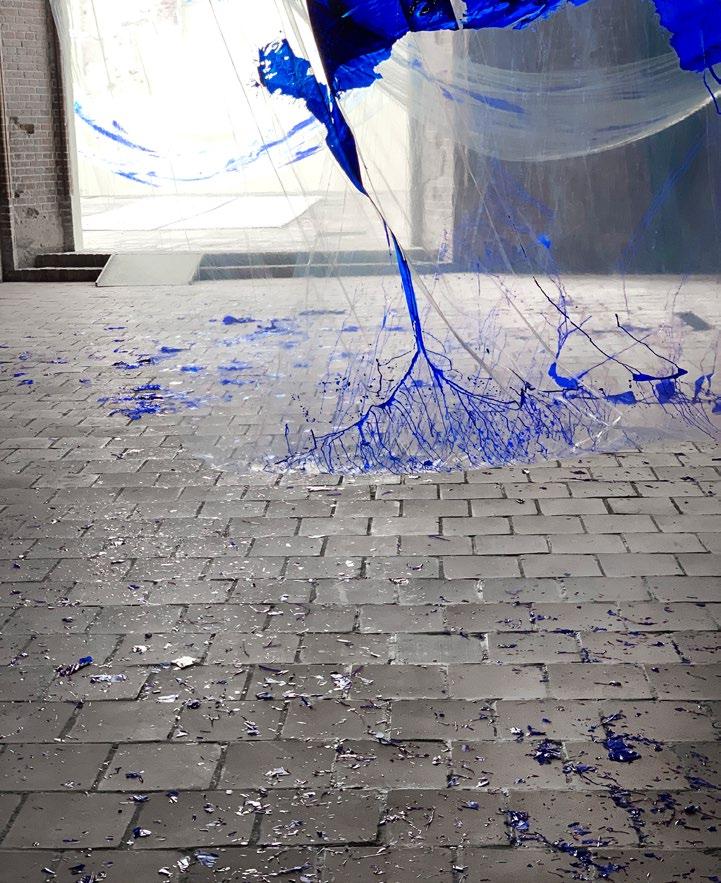
This artwork, by desig nating a space for the viewers, which is a space of encounter, wants to be something more than just an artefact, an object submitted to aesthet ic interpretations and artistic evaluation. This artwork wants to be a fact, an event, it wants to be something. Perhaps it is in this way that the qualitative, ontological leap, postulated by Hans Georg Gadamer, linked to the work of art is realised here, which consists in the fact that “the work of art does not only refer to something, but that what is pointed to is actually here, in this artwork itself. In other words: the work of art signifies a certain increment of be ing”. ➆ Everything indicates that the installation Bluemetries cont. may provide an excellent answer to the question of how in a work of art this increment of being can take place. It is an answer that escapes various theoretical dis courses, including the hermeneutical one, but appears before the viewers as a kind of elementary human experience.
➆
H.-G. Gadamer, Aktualność piękna. Sztuka jako gra, symbol i święto \ przeł. K. Krzemieniowa Warszawa 1993 \ s. 47.
H.-G. Gadamer, Aktualność piękna. Sztuka jako gra, symbol i święto \ transl. K. Krzemieniowa Warszawa 1993 \ p. 47.
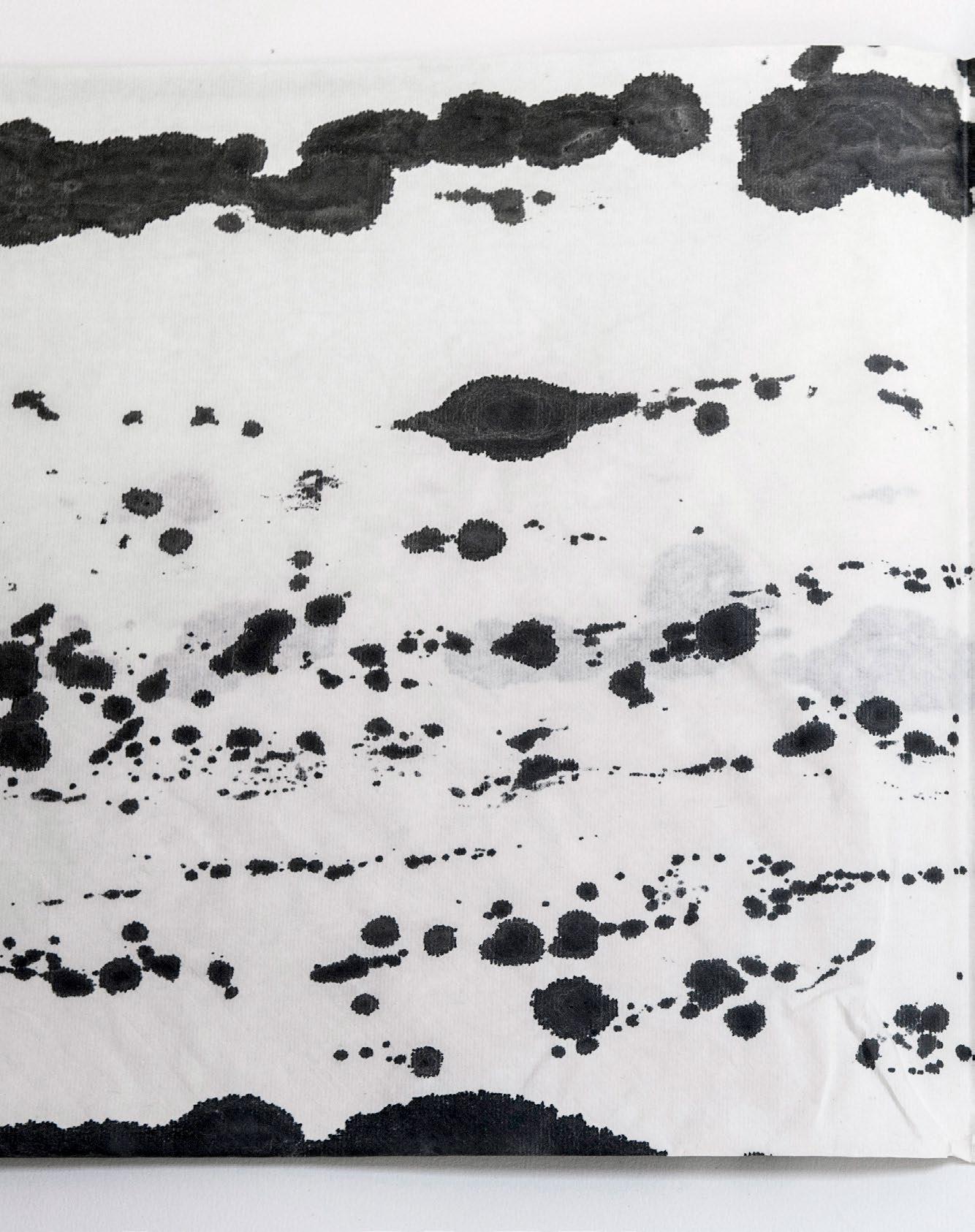
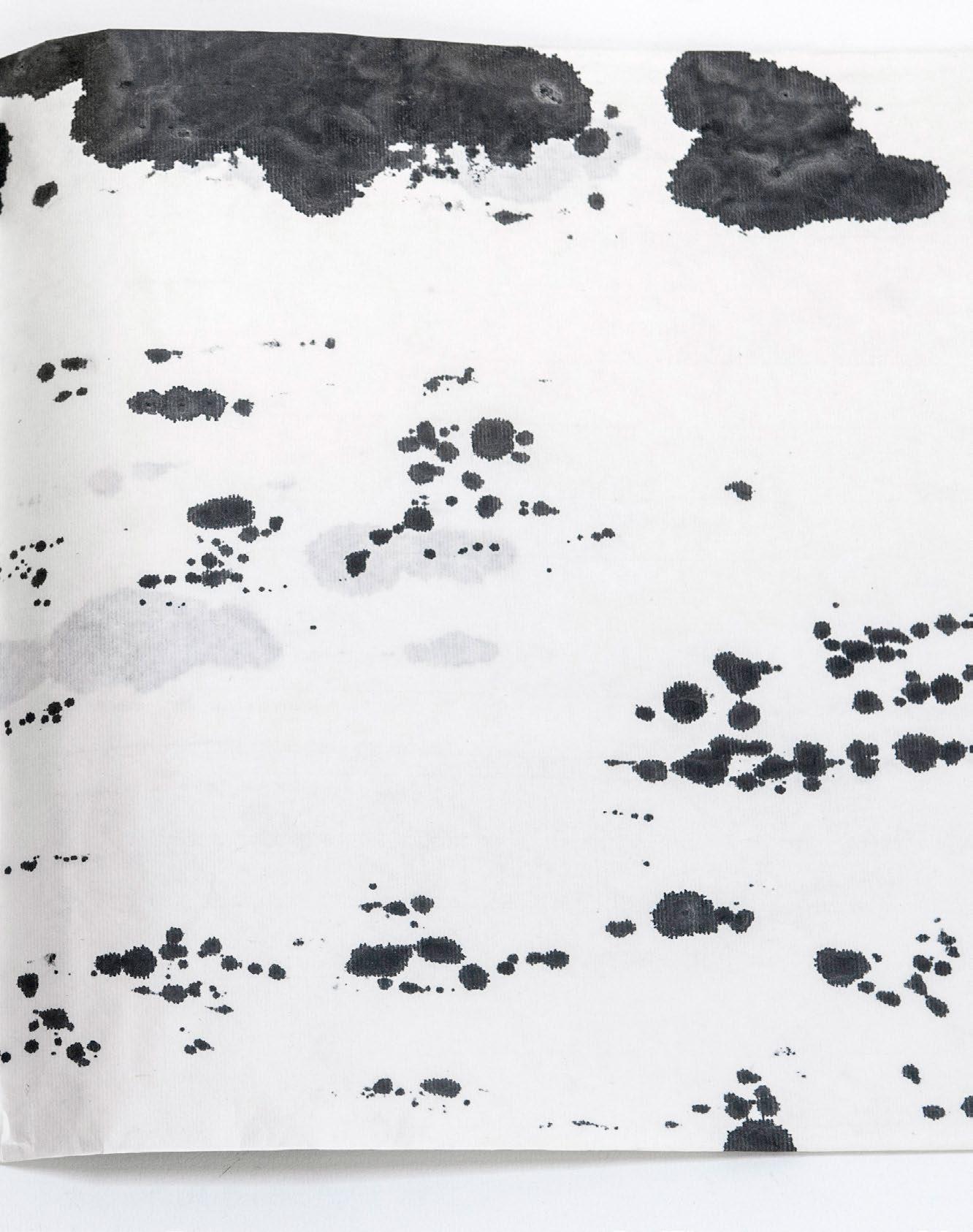
(...) obrazy zaś okazywały się zapisanymi śladami pewnego wydarzenia
while the images were recorded traces of a certain event
Niewysłane listy z Pekinu \ Unsent letters from Beijing \ 2013
Galeria Entropia we Wrocławiu \ Entropy Gallery in Wrocław
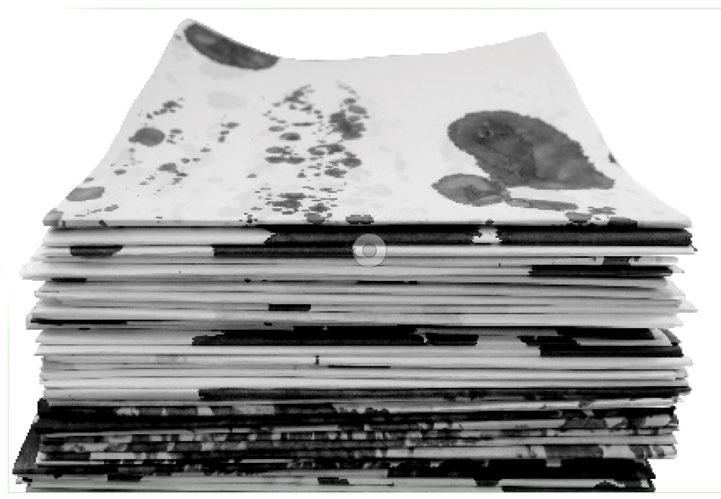
➇
Szczegółową analizę tych dzieł znaleźć można w tekstach: M. Śnieciński, Okna na utopię. Obrazy Urszuli Wilk [w:] Urszula Wilk [kat. wystawy], 7 czerwca – 31 lipca 2013 \ Muzeum Miejskie Wrocławia \ Stary Ratusz. Wrocław 2013; idem, Dzieło jako zdarzenie – performans rekonstruowany w wyobraźni \ „Dyskurs” 2018 \ nr 26.
A detailed analysis of these works can be found in the texts: M. Śnieciński, Okna na utopię. Obrazy Urszuli Wilk [in:] Urszula Wilk [exhibition cat.] \ City Museum of Wrocław 2013 \ Old Townhall \ Wrocław 2013 \ pp. 11-28; idem, Dzieło jako zdarzenie – performans rekonstruowany w wyobraźni, \ “Dyskurs” 2018 \ No. 26.
Najnowsza realizacja Wilk nawiązuje do wielu wcześniejszych dzieł artystki, w których występowały rozmaicie artykułowane pytania malarskie. Z jednej strony, krążyły one wokół kwestii obrazu (obrazów) i ich statusu ontologicznego, z drugiej natomiast skierowane były ku zagadnieniom odbioru dzieła, a więc ku wytyczaniu i definiowaniu pola gry dla odbiorcy. Ku definiowaniu roli, jaką musi on odegrać w przestrzeni (fizycznej i intelektualnej) stwarzanej przez dzieło. W tym kontekście niezwykle ważny stawał się również performatywny wymiar niektórych realizacji Wilk, obecny np. w seriach prac na papierze z lat 2009–2012, noszących wspólny tytuł Niewysłane listy (poszczególne części to Archipelagi, tytułowe Niewysłane listy oraz Nieobecność ). W seriach owych w tkankę obrazów artystka wpisała specyficzne malarskie performansy, lecz były to performansy, które widz musiał rekonstruować w wyobraźni, obrazy zaś okazywały się zapisanymi śladami pewnego wydarzenia ➇.
Wilk’s latest implementation refers to many of her earlier works, in which there appeared variously articulated painting questions. On the one hand, these questions revolved around the issue of the image(s) and their ontological status, while on the other, they addressed the issues of the reception of a work of art, that is, the delineation and definition of the field of play for the viewer. They addressed the definition of the role that the viewer has to play in the space (physical and intellectual) created by the work. In this context, also extremely important was the performative dimension of some of Wilk’s implementations, present for instance in the series of works on paper from 2009–2012, collectively called Niewysłane listy ([Unsent letters] the individual parts being Ar chipelagi [ Archipelagos], the title Niewysłane listy, and Nieobecność [ Absence]). In these series, the artist inscribed specific painting per formances into the tissue of her images, but these were performances that the viewer had to reconstruct in their imagination, while the images were recorded traces of a certain event. ➇

Niewysłane listy z Pekinu \ Unsent letters from Beijing \ 2013
Galeria Entropia we Wrocławiu \ Entropy Gallery in Wrocław
\ 2018
W instalacji Bluemetrie cd. z 2021 r. performans ma bardziej namacalny charakter – z jednej strony, oglądający muszą dokonać wyobraźniowej rekonstrukcji działania malarskiego artystki, a z drugiej – zachęceni przez autorkę, wchodząc w przestrzeń dzieła, będą musieli realizować swój własny performans odbioru. Powinni zanurzyć się w tej instalacji i zacząć doświadczać jej specyficznej gęstości. Stać się swoistymi interpretatorami i wykonawcami dzieła, czekającego jakby w uśpieniu. Zawarta w nim potencja musi być zaktywizowana i urzeczywistniona przez widza, który doświadczając go, zarazem wydobywa ukryte w nim znaczenia i nadaje mu sens. W owym doświadczaniu gęstości tkwi pewien paradoks, gdyż w instalacji tej mamy przecież do czynienia ze strukturą, której istotną cechą jest transparentność. Nie tylko patrzymy tu na obrazy, lecz patrzymy też poprzez obrazy.
In the installation Bluemetries cont. from 2021, the performance has a more tangible character – on the one hand, the viewers have to make an imaginary reconstruction of the artist’s painting action, and on the other hand, encouraged by the painter, entering the space of the work, they will have to perform their own original performance of reception. The viewers must immerse themselves in the installation and begin to experience its specific density. They must become kind of interpreters and performers of the artwork waiting as if dormant. The potential it contains must be activated and realised by the viewer who, experiencing the artwork, at the same time extracts its hidden meanings and gives it meaning. There is a certain paradox in this experience of density, because in this installation we are dealing with a structure whose essential feature is transparency. We are not only looking at images here, but we are also looking through images.
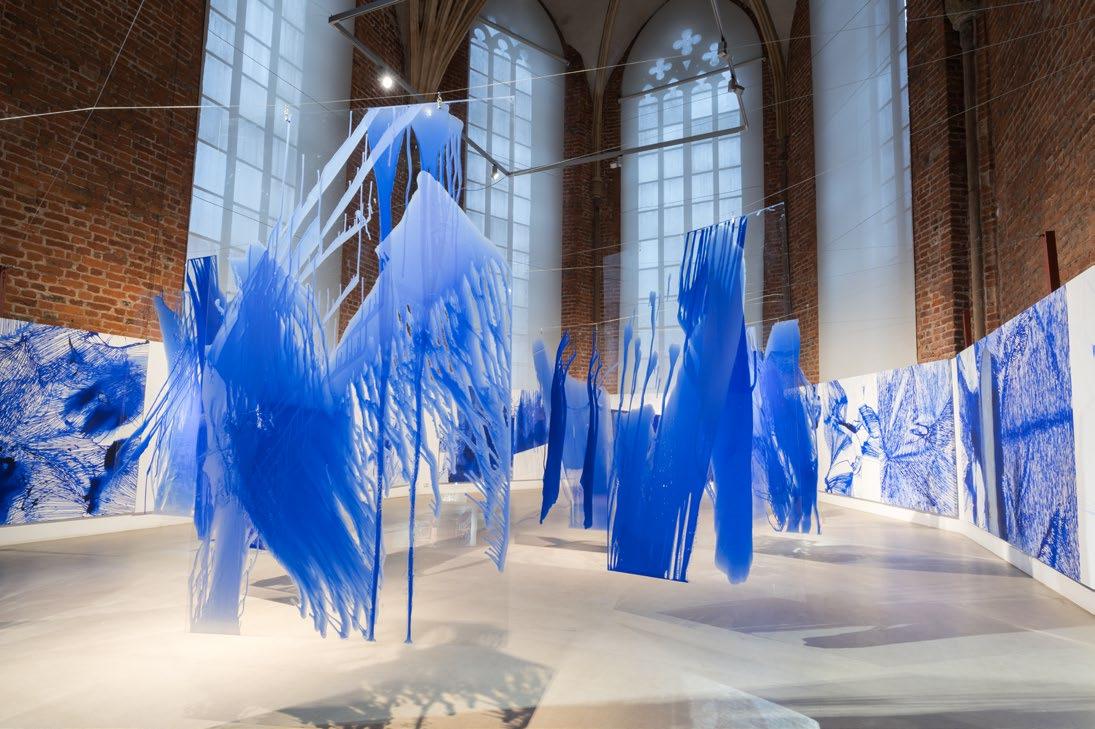
➈
H.-G. Gadamer, op. cit. \ s. 58–61.
H.-G. Gadamer, op. cit. \ s. 58–61.
U. Wilk \ niepublikowana…
U. Wilk \ unpublished…
Instalacja – limitowana kubaturą miejsca – z jednej strony zawłaszcza i przedefiniowuje zastaną przestrzeń, z drugiej zaś otwiera się też na nią, wzmacnia jej rytmy, ujawnia jej charakter, nadaje jej gęstość i smak. W akcie odbioru trzeba porzucić wygodny i bezpieczny podmiotowo przedmiotowy schemat, akt odbioru staje się tu czymś w rodzaju autorskiej interpretacji kompozycji stworzonej przez artystkę. Malarska instalacja Wilk ma charakter czasoprzestrzenny. Odbiorca musi wybrać swój specyficzny sposób poruszania się w dziele, musi – intuicyjnie – dostosowywać tempo ruchu, ustalać jego kierunki, określać czas niezbędny na wędrówkę w przestrzeni dzieła. To aktywne czytanie, to naznaczanie sobą, swoją obecnością poszczególnych fragmentów jest zarazem – by odwołać się tu ponownie do rozważań Gadamera –odsłanianiem „czasu właściwego” czy też „czasu własnego” tej instalacji, jest odkrywaniem jej struktury czasowej ➈ Efemeryczność i niestabilność materii, z której wykonana została ta rozbudowana malarska realizacja, równoważona jest stabilnością architektonicznej, przestrzennej ramy, ale warto zwrócić uwagę, że owa architektoniczna rama nie stanowi czegoś zewnętrznego wobec dzieła, lecz że zastana przestrzeń ulega tutaj niejako wciągnięciu w strukturę realizacji, że staje się jej aktywnym, działającym elementem – m.in. za sprawą transparentności materii, z której artystka zbudowała swe dzieło. To oczywiście zamierzony efekt – Wilk w różnych warunkach przestrzennych (pracowni, ogrodu itp.) sprawdzała oddziaływanie owych transparentnych obrazów, weryfikowała powstające interferencje i synergię poszczególnych elementów przestrzeni, mając nadzieję, że „malarstwo wtopi się w otoczenie, tworząc w ten sposób efemeryczne obrazy, które będą nieustannie rekonstruowane w miarę poruszania się, przemieszczania się widzów” ➉
On the one hand, the installation –limited by the volume of the place –appropriates and redefines the existing space, while on the other hand it also opens up to it, strengthens its rhythms, reveals its character, gives it density and flavour. In the act of reception one has to abandon the comfortable and safe subject object scheme, the act of reception becomes here something like an own authorial interpretation of the composition created by the artist.
Wilk’s painting installation is space time in nature. Viewers muschoose their own specific way of moving around in the work, they must – intuitively – select the pace of movement, determine its directions, define the time that will be necessary for them to wander in the space of the work. This active reading, this marking with oneself, with one’s presence, of individual fragments is at the same time – to refer again to Gadamer’s deliberations – a revealing of the “proper time” or “own time” of this installation, a revealing of its time structure. ➈ The ephemerality and instability of the matter of which this elaborate painting installation is made is counterbalanced by the stability of the architectural, spatial frame, but it is worth noting that this architectural frame is not something external to the work, but that the existing space is somehow dragged into the structure of the creation, that it becomes its ac tive, functioning element, owing in part to the transparency of the matter out of which the artist has built her composition. This is, of course, an intended effect – in various spatial conditions (atelier, garden, etc.), Wilk has tested the impact of these transparent images, verified the resulting interference and synergy of individual elements of space, hoping that “painting will blend into its surroundings, thus creating ephemeral images that will be continually reconstructed in the course of the viewers". ➉
The viewer, who becomes immersed in
Odbiorca, zanurzywszy się w przestrzeni dzieła, staje się świadomym lub nieświadomym uczestnikiem i wykonawcą tej czasoprzestrzennej partytury malarskiej. Dzieło Wilk oferuje różnorodne możliwości interpretacyjne, jest otwarte na wiele różnych potencjalnych sposobów odczytywania, będzie rezonatorem dla rozmaitych typów wrażliwości i dla wielu odmiennych temperamentów. Nikogo nie wykluczając, oferuje odbiorcom przestrzeń spotkania – w tej przestrzeni widzowie muszą zadać sobie kilka ważnych pytań, dotyczących m.in. ich indywidualnej tożsamości, gdyż ostatecznie stawką gry, w którą się tutaj można zanurzyć, jest właśnie po prostu tożsamość. Uczestnicząc w takiej grze, odbiorcy godzą się na to, że w jej trakcie będą musiały zabrzmieć pytania: „Kim jesteś?”, „Z czym tu przychodzisz?”. Nie są one zadawane wprost – artystka raczej stwarza tu tylko warunki, w których będą mogły wybrzmieć pytania, jakie każdy z oglądających przyniesie ze sobą. Urszula Wilk mówi:
Chciałabym, aby dla widza był to powrót do nieistnienia, przedistnienia. Całkowite zanurzenie się w błękicie, absolutne wyłączenie wszystkich emocji związanych z egzystencją, z życiem, bycie poza czasem, fizyczne poczucie, że człowiek jest integralną częścią przestrzeni. Rodzaj doznania podobnego do wejścia do wody, zanurzenia się i całkowitego uwolnienia się od grawitacji
Symbiotyczna łączność ze światem –być może właśnie w tej sferze czeka na nas doznanie szczęścia.
the space of the work, becomes a conscious or unconscious participant and performer of this space time painting score. Wilk’s work offers a variety of interpretative possibilities, it is open to many different potential ways of reading, it will be a resonator for various types of sensitivity and for many different tempera ments. Without excluding anyone, it offers viewers a space of encounter – in this space viewers must ask themselves some important questions concerning, among others, their own identity, because ultimately the game at stake here is nothing less than identity. By becoming participants in such a game, the viewers accept that in the course of it the questions will have to be asked: “Who are you?”, “What do you come here with?”. These identity questions are not asked directly; rather, the artist creates here only the conditions in which the questions that each of the viewers brings with them will have a chance to resound. Urszula Wilk explains:
I would like it to be for the viewer a return to non-ex istence, pre-existence. A total immersion in the blue, an absolute exclusion of all emotions related to existence, to life, being out of time, the physical feeling that one is an integral part of space. A kind of sensation similar to entering water, immersing oneself and being completely free from gravity.
A symbiotic connection with the world –per haps it is in this realm that the experience of happiness awaits us.
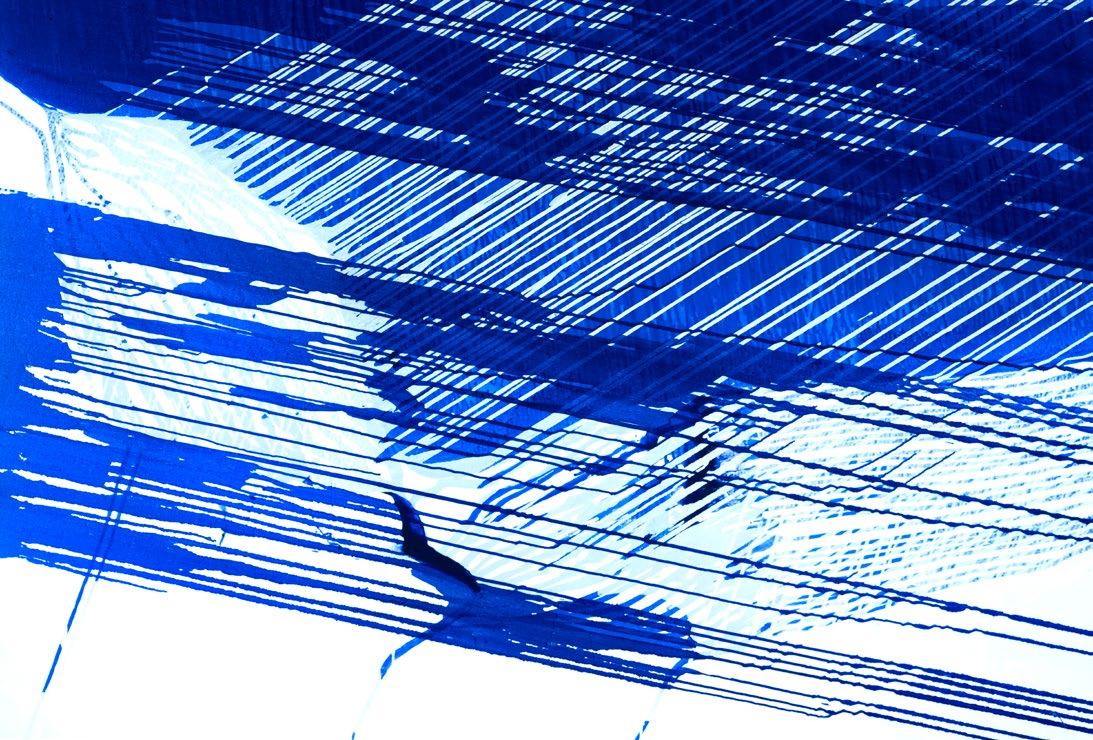

Bluemetrie, las, pola \ Bluemetries, forest, fields \ 2020–2024
Czasoprzestrzenne zagadki
obrazów
Urszuli Wilk
Marek Śnieciński
W ostatnim czasie Urszula Wilk kontynuuje zgłębianie tajemniczych związków czasu i przestrzeni, kolejne wystawy, następne nieoczywiste miejsca i scenerie są dla niej okazją do ponawiania i przeformułowywania artystycznych pytań. Wydaje się, że źródłową przestrzenią, w której pojawiają się one, w której formułowane są i weryfikowane jej artystyczne intuicje, bywa przestrzeń ogrodu w Księżycach. Ogród ten artystka od lat kształtuje, żyje w nim (razem z nim), doświadcza jego przemian związanych z czasem (rośnięcie roślin, rytmy wegetacji wyznaczone porami roku), nic dziwnego zatem że właśnie tutaj pojawiały się jej malarskie instalacje, które możemy oglądać w postaci rejestracji filmowych, czyli patrzeć na nie jak na rodzaj malarskiego do kamerowego performance’u.
Space-time riddles
of Urszula Wilk's paintings
Recently, Urszula Wilk continues to explore the mysterious relationships between time and space, subsequent exhibitions, subsequent non obvious places and settings are for her an opportunity to renew and reformulate her artistic questions. It seems that the source space in which they appear, in which her artistic intuitions are formulated and verified, happens to be the space of the garden in Księżyce. For years, the artist has been shaping this garden, living in it (together with it), experiencing its transformations connected with time (the growth of plants, the rhythms of vegetation determined by the seasons), so there is no wonder that it is here that her painterly installations emerged, which we can watch in the form of film recordings, or look at as a kind of painterly to camera performance.
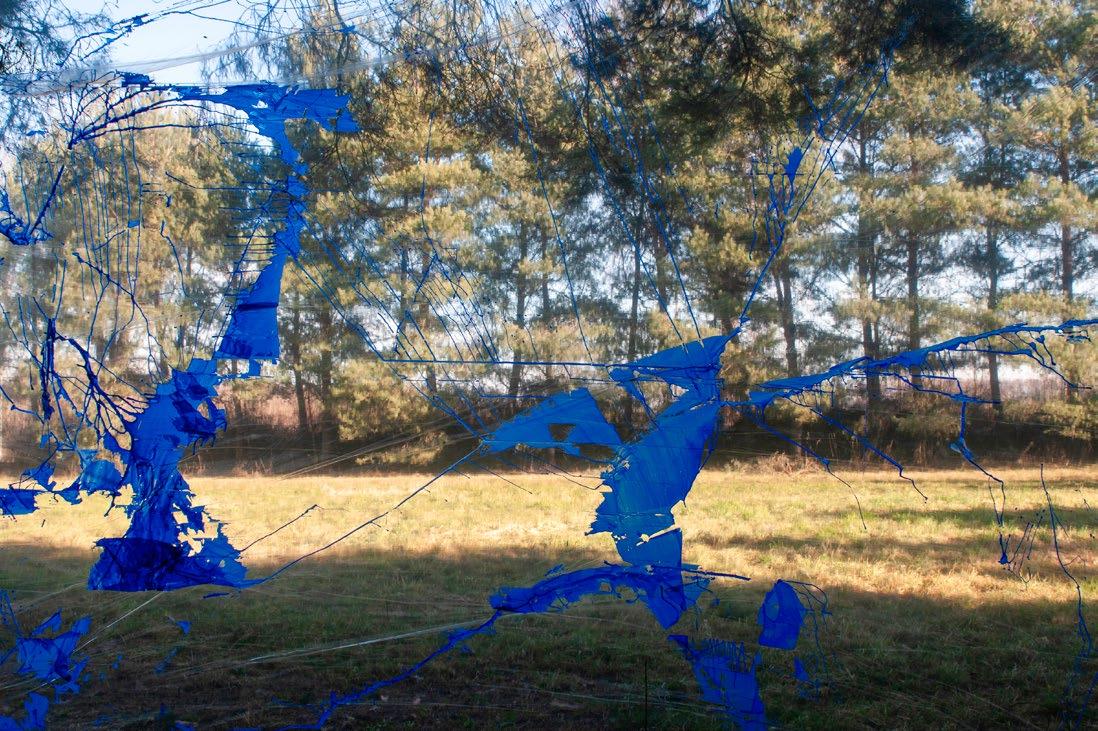
Bluemetrie, las, pola \ Bluemetries, forest, fields \ 2020–2024
Film zrealizowany pewnej jesieni ujawnia, że jesień to bardzo zaborcza pora roku, jej barwy konkurują ze śladami błękitu na foliach, błękit musi się z nimi „dogadać”, musi wywalczyć wśród nich swoje miejsce.
The film, made one autumn, reveals that autumn is a very possessive time of year, its colours competing with the traces of blue on the foils, the blue must ‘get along’ with them, must win its place among them.
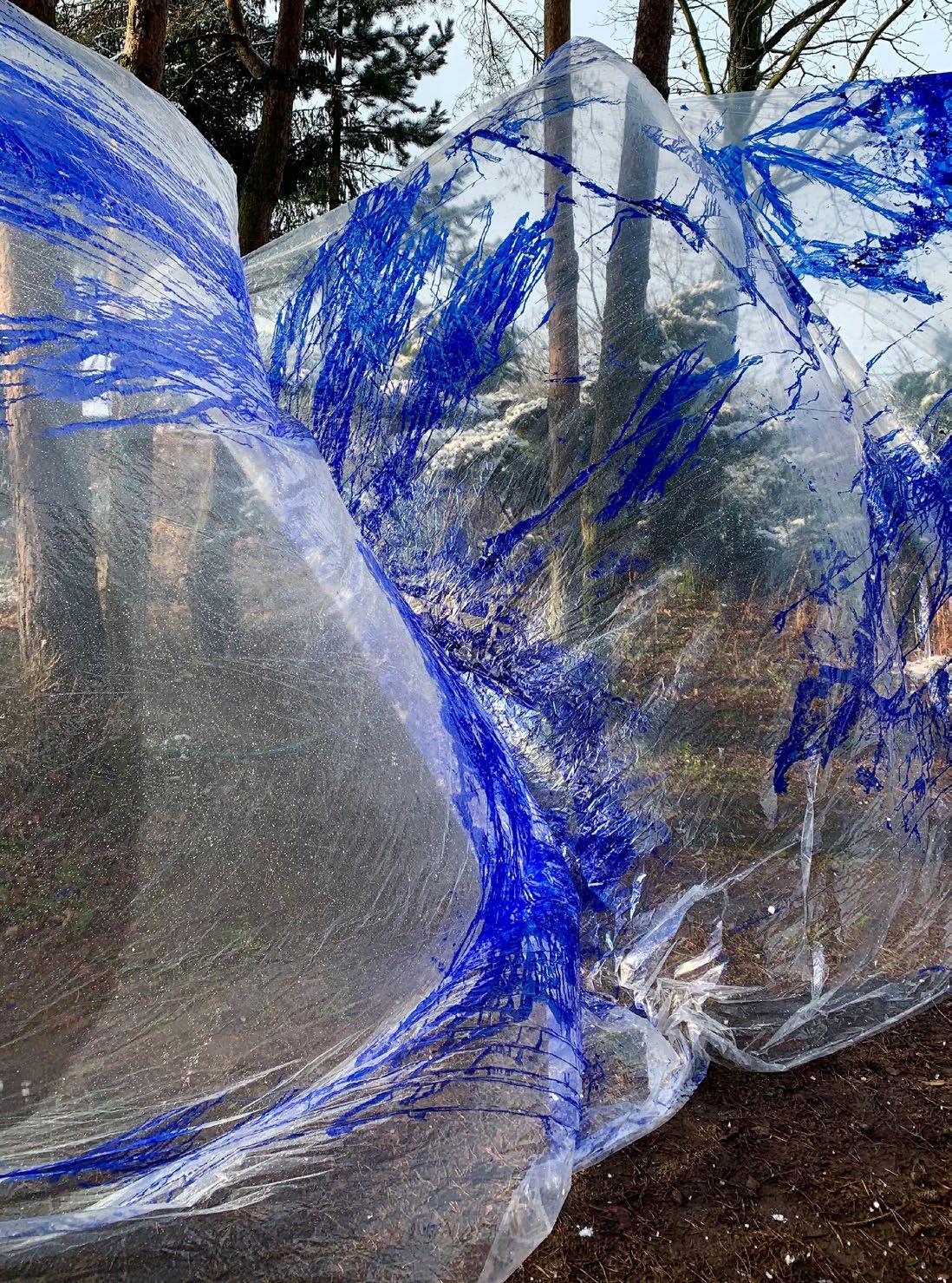
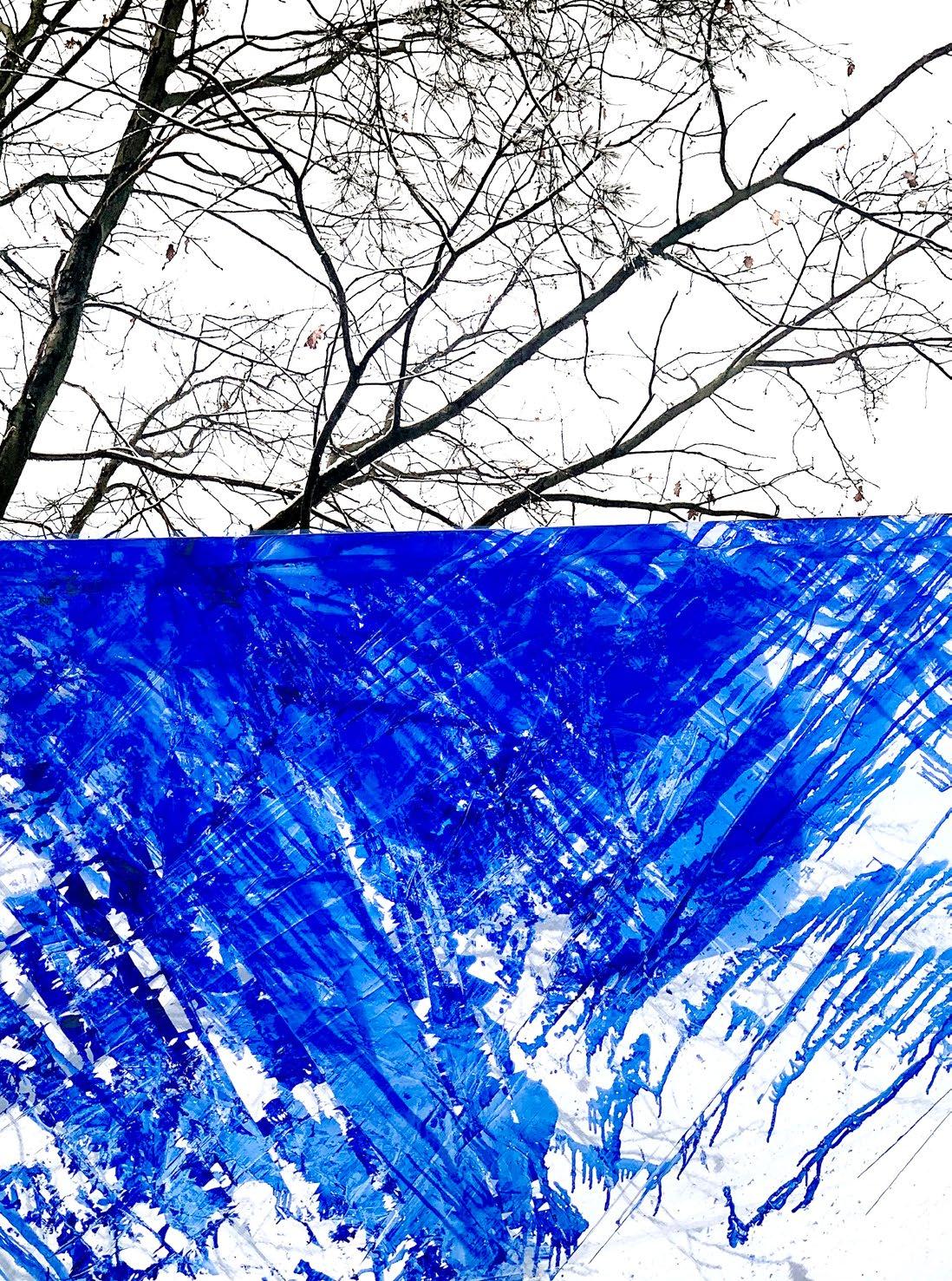
Zupełnie inne doznania towarzyszą nam, gdy oglądamy poruszane wiatrem folie rozwieszone wśród zimowego pejzażu – taka sceneria nadaje wyjątkową moc błękitowi. Na tle czarno białych form drzew, zmrożonych traw i krzewów widoczne na pierwszym planie strzępy błękitu wydają się pochodzić z innego świata, z innego czasu, który niespodzianie zabłąkał się tutaj na chwilę.
We have a completely different impression when we look at the wind stirred foils hung amidst the winter landscape – such a setting endows the blue with a unique power. Against the background of the black and white forms of the trees, frozen grasses and bushes, the shreds of blue visible in the foreground seem to come from another world, from another time, which has unexpectedly strayed here for a moment.
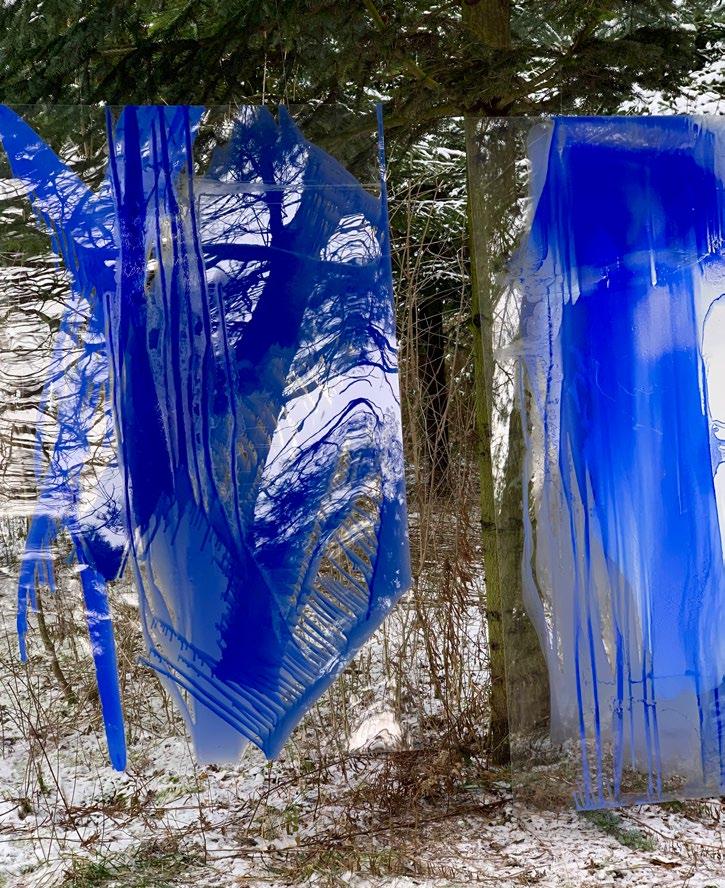
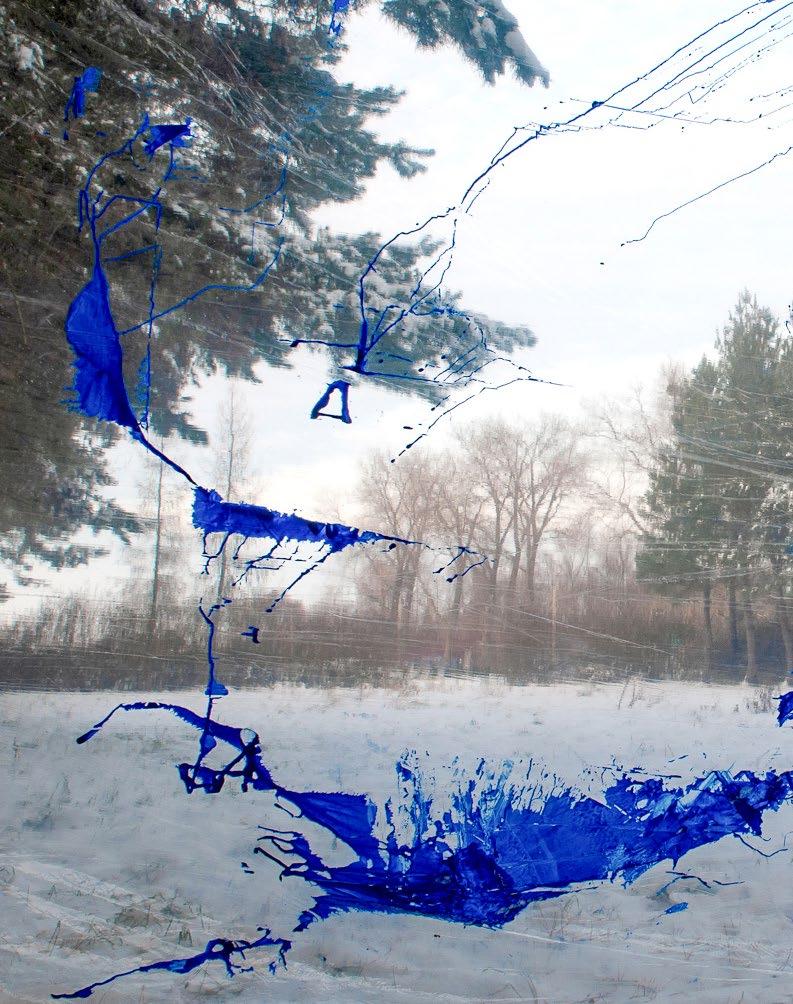
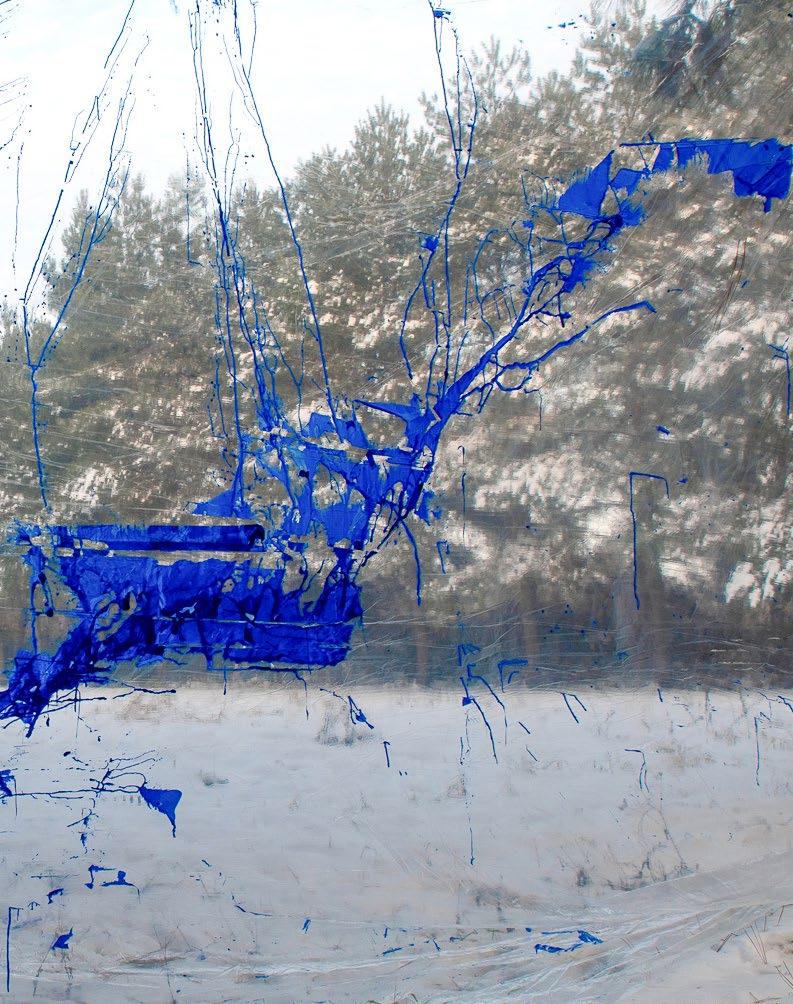

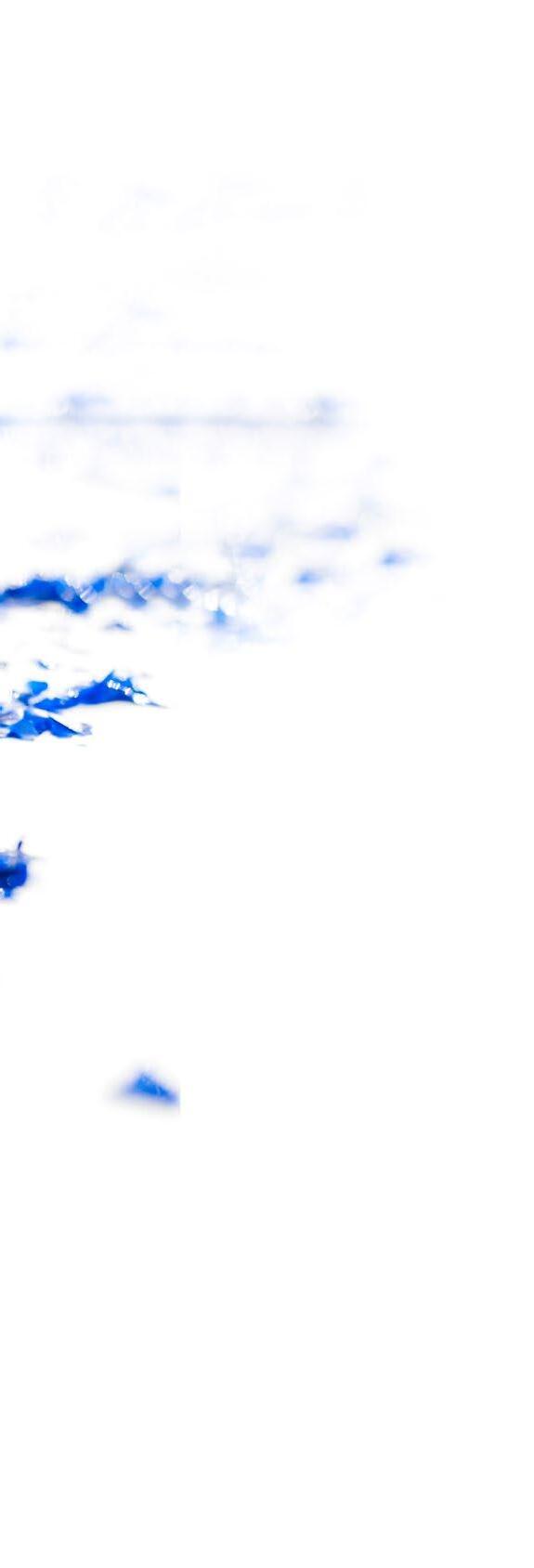
To sprasowany czas (...), który pojawia się przed nami w postaci niepozornych, skrojonych na ludzką miarę czasoprzestrzennych zagadek (...)
It is a compressed time (...) that appears before us in the form of inconspicuous, space-time riddles (...)
Rejestracje owych malarskich performance’ów towarzyszą od pewnego czasu wystawom artystki, widzieliśmy je np. w 2022 roku w Galerii Geppart we Wrocławiu (wystawa Płynność światła, tańce pielgrzymującej wody ), gdzie –oprócz dzieł na ścianach – Wilk ułożyła na podłodze galerii szereg białych płócien. Była to kontynuacja i rozwinięcie pomysłu z wystawy w Elblągu, gdzie pierwszoplanową rolę odgrywała metafora gęstości przestrzeni, tutaj natomiast owe podobrazia były terytorium, na którym przede wszystkim ujawnia się czas, w tym przypadku w jednej ze swych najbardziej zagadkowych postaci, czyli czasu przeszłego, dokonanego, choć nieokreślonego. Mieliśmy tu więc do czynienia z tym tak tajemniczym trybem czasowym, jakim jest aoryst, zaś strzępy błękitnej barwy rozsypane na płótnach były wspomnieniem po błękicie, który kiedyś „żył” na foliach rozwieszonych w ogrodzie w Księżycach lub umieszczanych w przestrzeniach ekspozycyjnych. To sprasowany czas, destylat czasu i przestrzeni, który pojawia się przed nami w postaci niepozornych, skrojonych na ludzką miarę czasoprzestrzennych zagadek lub – mówiąc językiem współczesnej fizyki i astronomii – czasoprzestrzennych osobliwości. A przecież sama czynność wydaje się tak prosta – trzeba troskliwie pozbierać opadłe z folii strzępy błękitu, przechować je pieczołowicie a następnie wnieść do galerii i rozsypać na przygotowanym dla nich podobraziu.
Recordings of these painting performances have accompanied the artist’s exhibitions for some time; we saw them, for example, in 2022 at the Geppart Gallery in Wrocław (the Fluidity of Light, Dances of Pilgrim Water exhibition), where – in addition to the works on the walls – Wilk arranged a number of white canvases on the gallery floor. This was a continuation and development of the idea from the exhibition in Elbląg, where the metaphor of the density of space played a prominent role, while here the supports were a territory where time, in this case in one of its most mysterious forms, i.e. past, perfect, though indefinite time, was revealed. Here, then, we were dealing with that so mysterious mode of time that is the aorist, while the shreds of blue scattered on the canvases were a memory of the blue that once ‘lived’ on foils hung in the garden in Księżyce or placed in exhibition spaces. It is a compressed time, a distillate of time and space that appears before us in the form of inconspicuous, spacetime riddles tailored on human scale or – to use the language of contemporary physics and astronomy – space time singularities. Although the activity itself seems so simple – you have to carefully collect the shreds of blue that have fallen from the foil, store them diligently and then bring into the gallery and scatter on the supports prepared for them.
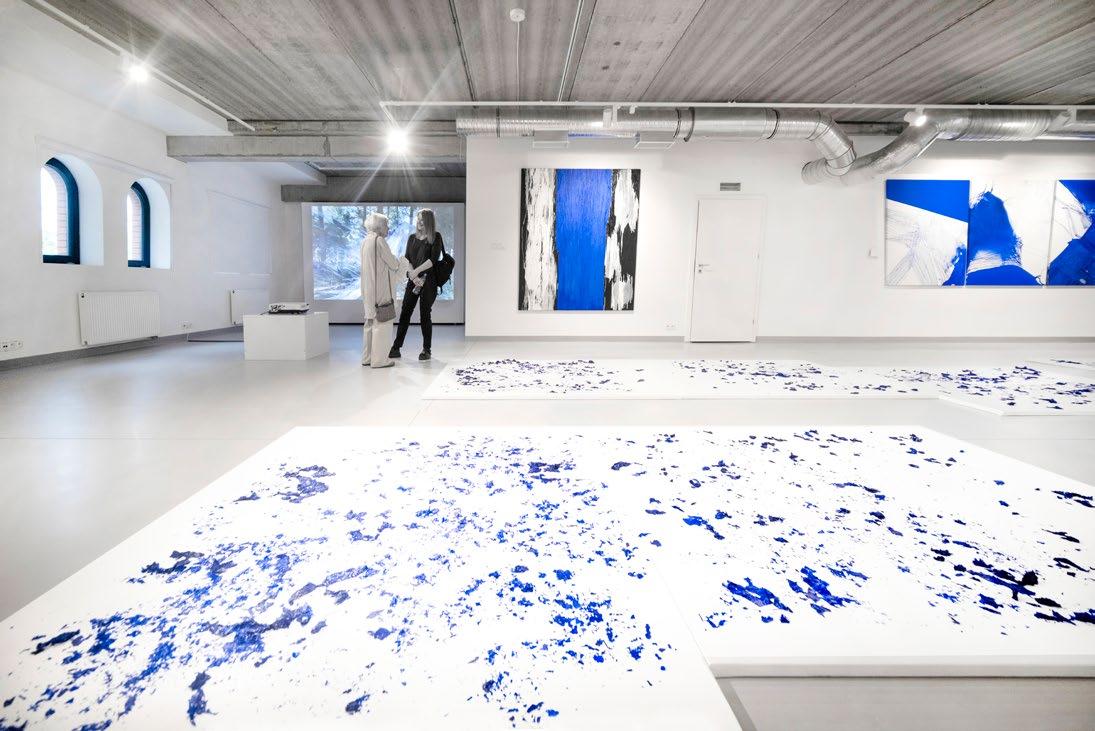
Płynność światła, tańce pielgrzymującej wody \ The Fluidity of Light, Dances of Pilgrim Water \ 2022
Galeria Geppart we Wrocławiu \ Geppart Gallery in Wrocław
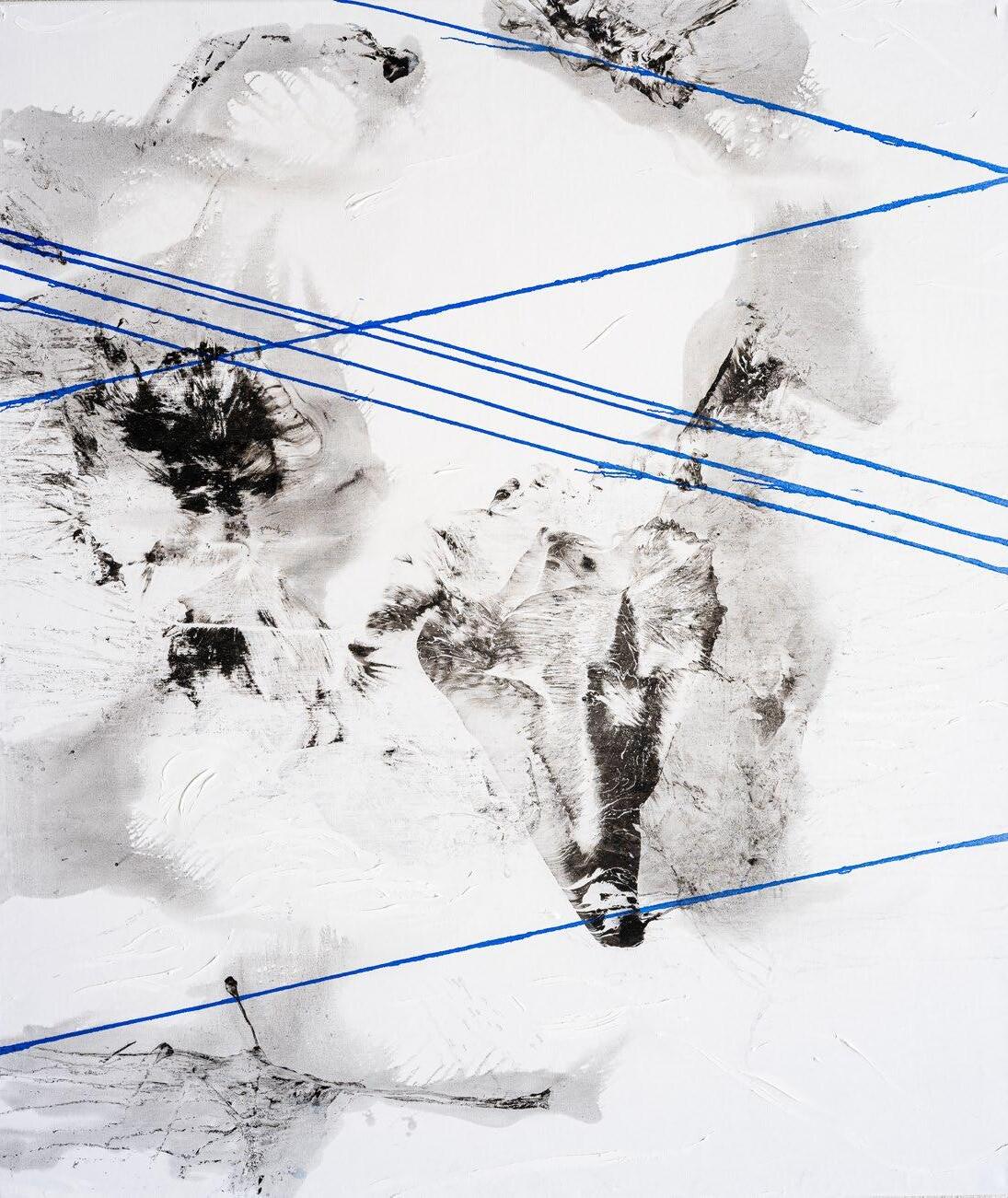
Seria Topografie z błękitną linią \ Topographies with Blue Line Series\ 2022–23
olej na płótnie \ oil on canvas \ 200 × 170 cm
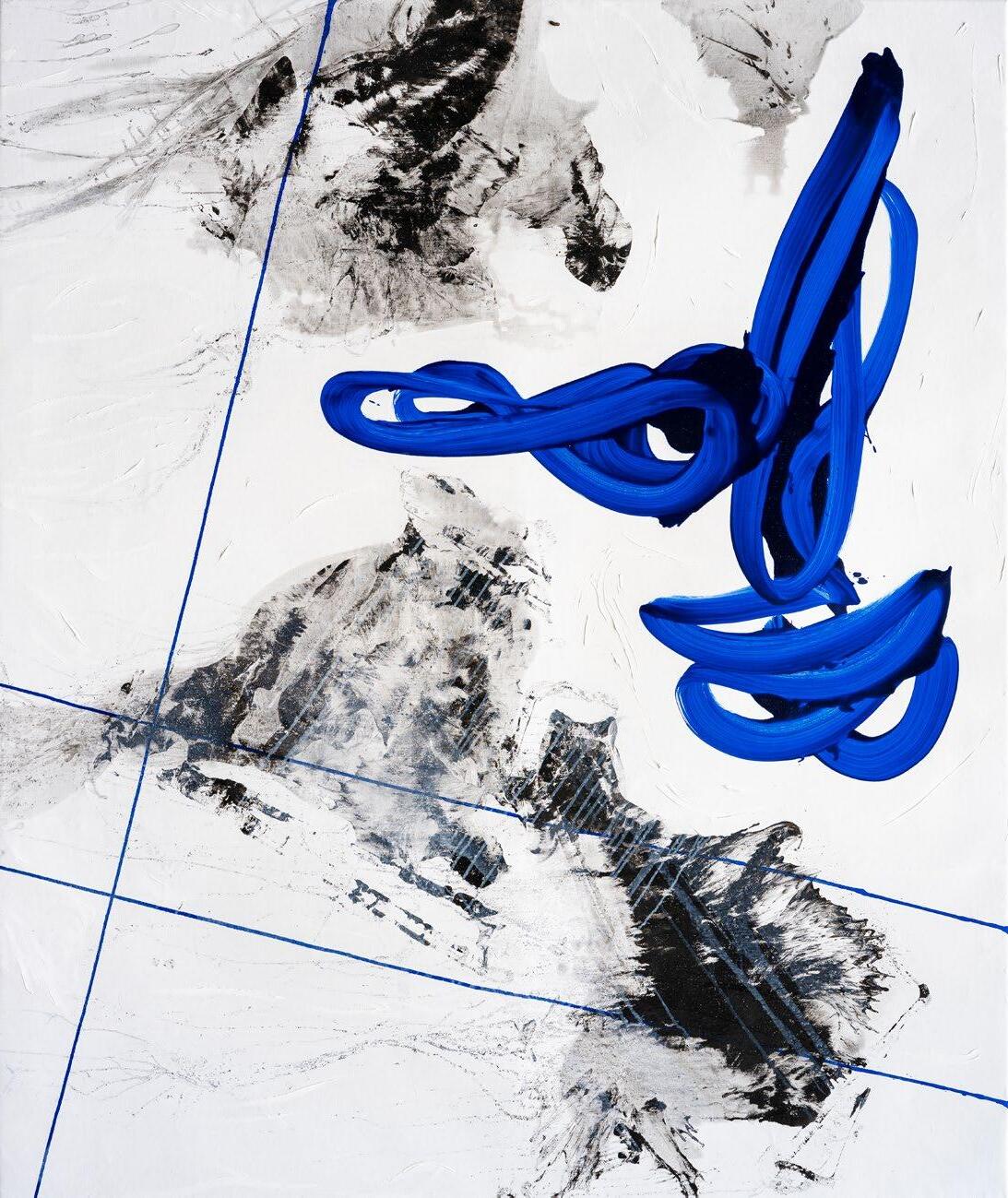
Topografie z błękitną
\ Topographies with Blue Line Series \ 2022–23
olej na płótnie \ oil on canvas \ 200 × 170 cm
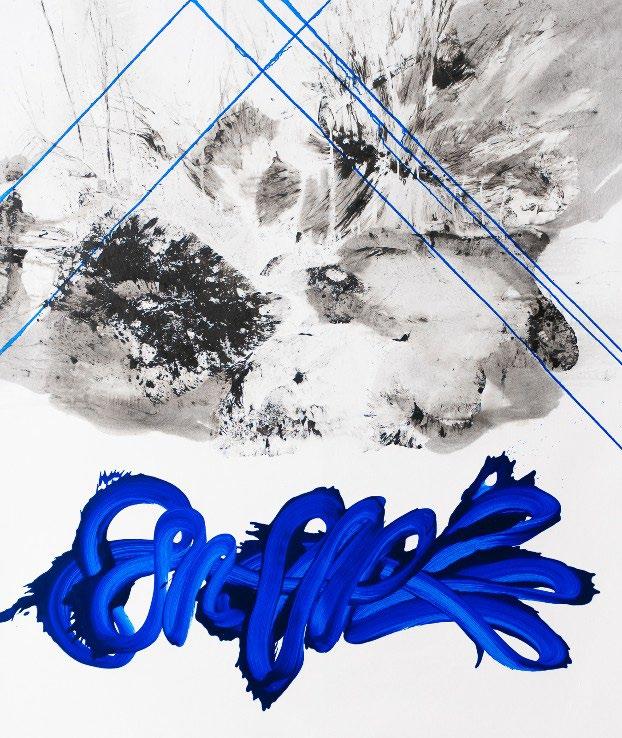
Seria Topografie z błękitną linią \ Topographies with Blue Line Series \ 2022–23
olej na płótnie \ oil on canvas \ 200 × 170 cm
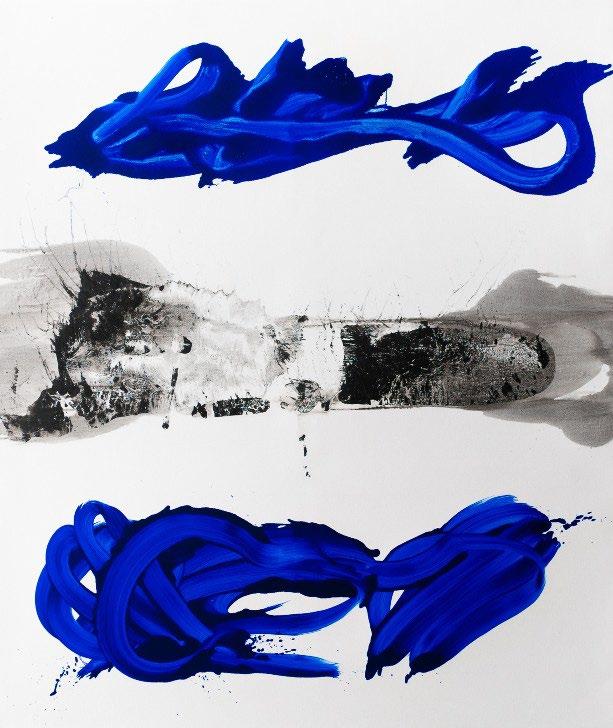
Seria Topografie z błękitną linią \ Topographies with Blue Line Series \ 2022–23
olej na płótnie \ oil on canvas \ 200 × 170 cm
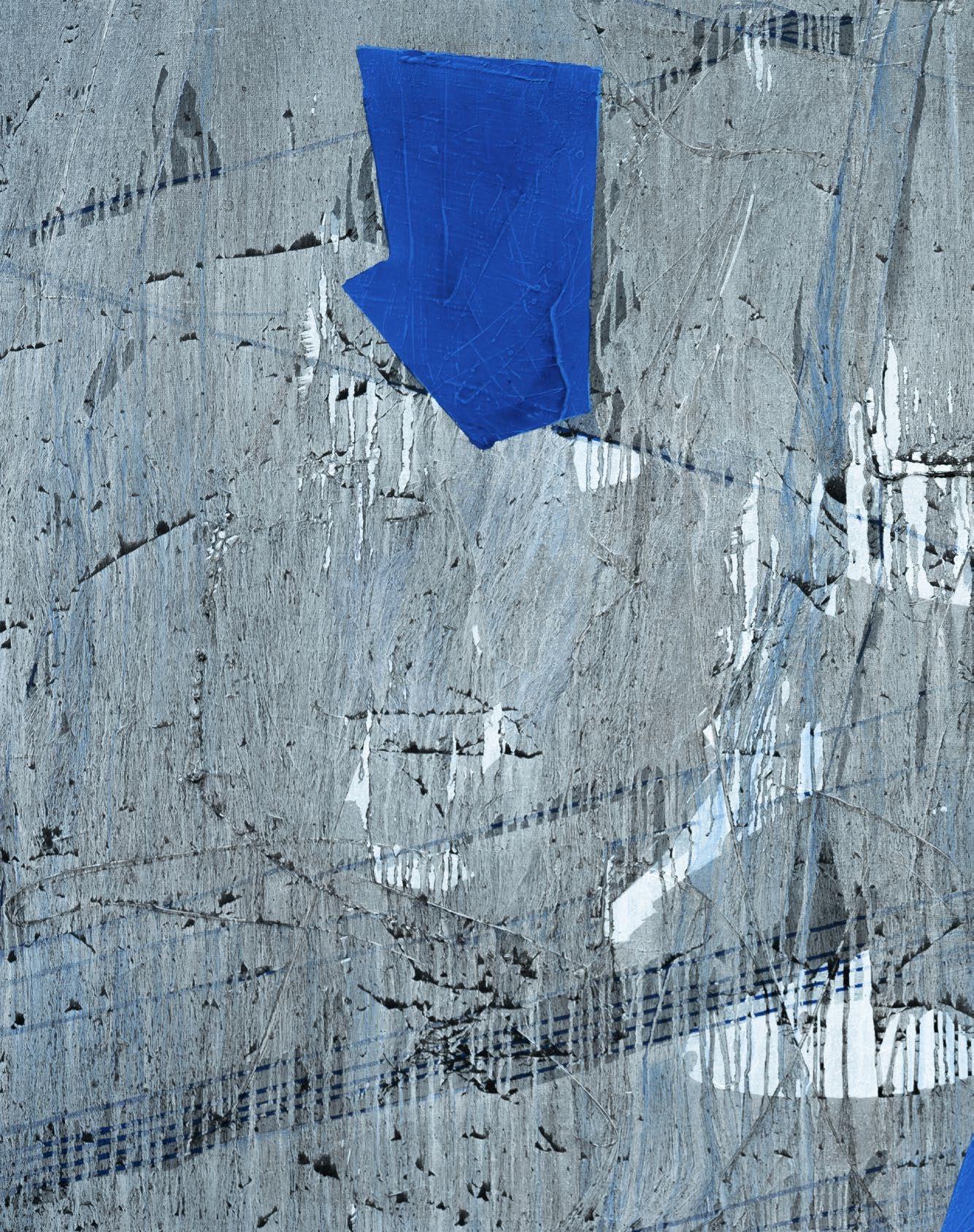
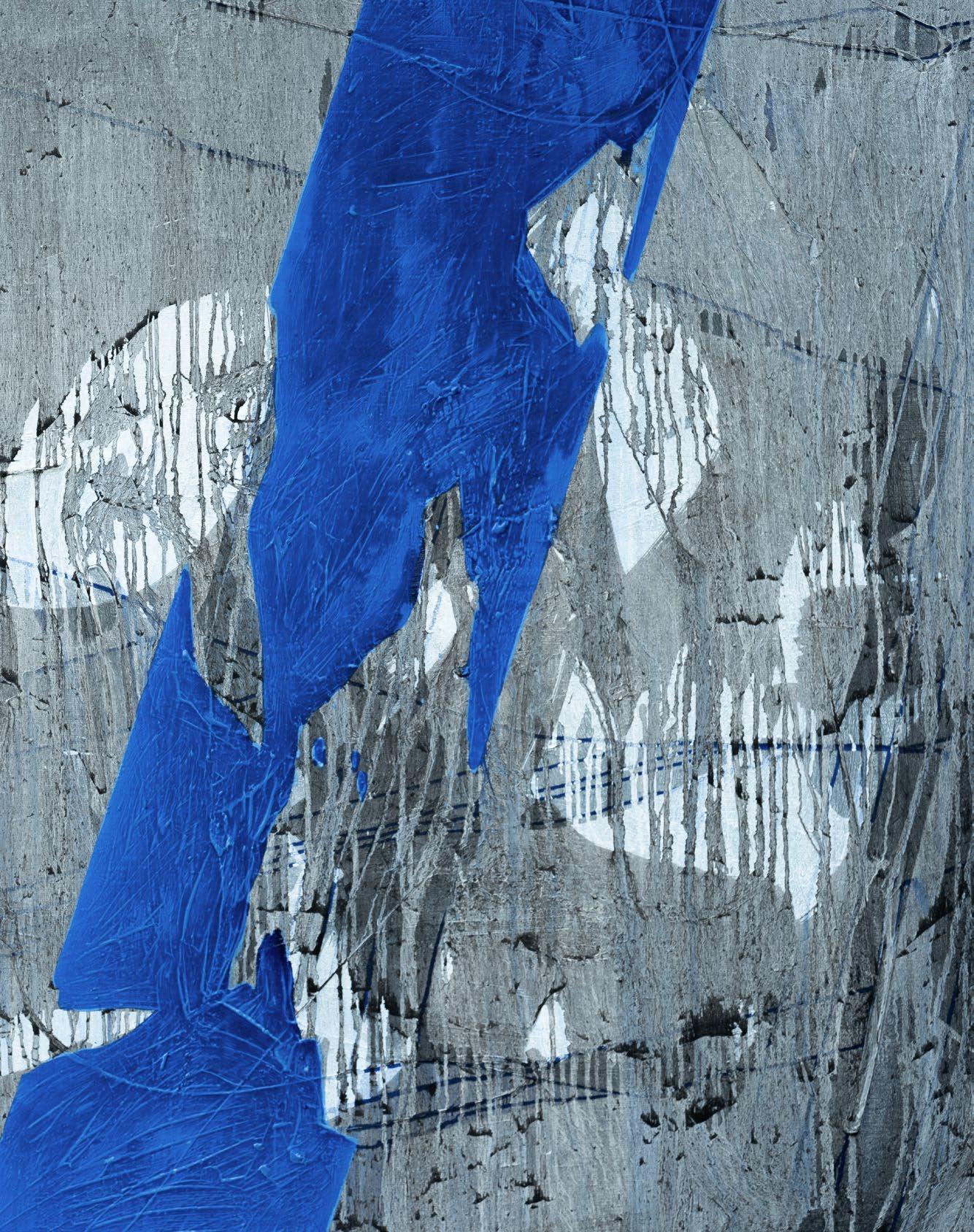

Linie \ The Lines \ 2023
← Bez tytułu \ Untitled \ 2024
olej na płótnie \ oil on canvas \ 140 × 200 cm
Centrum Nauki, Kultury i Sztuki Stara Kopalnia w Wałbrzychu \ Stara Kopalnia Centre for Science, Culture and the Arts in Wałbrzych
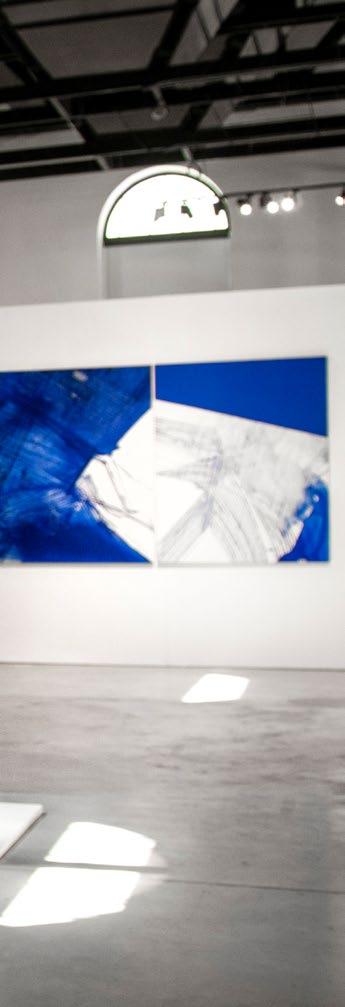
Na wystawie w Centrum Nauki, Kultury i Sztuki Stara Kopalnia w Wałbrzychu Urszula Wilk zaprezentowała serię prac zatytułowanych Topografie z Błękitną Linią, w której poszczególne obrazy to malarski frottage rozegrany w czerniach, szarościach i bielach, na który – w ostatniej fazie malowania – artystka naniosła linie (białe, czarne, błękitne) oraz, na koniec, malowane szerokim pędzlem sploty błękitu. Topografie z Błękitną Linią nawiązują do dzieł Wilk na papierze powstałych w 2012 r. podczas rezydencji w Chinach w Shang Yuan Art Museum (Archipelagi i Niewysłane listy z Pekinu), do stosowanych w tamtych pracach rozwiązań technicznych. Warto przypomnieć sobie, że w Archipelagach podłoga pracowni stawała się terytorium, na którym artystka umieszczała krople tuszu kapiące z pędzla.
At an exhibition at the Stara Kopalnia Centre for Science, Culture and the Arts in Wałbrzych, Urszula Wilk presented a series of works entitled Topographies with a Blue Line, in which the individual paintings were a painterly frottage played out in blacks, greys and whites, onto which – in the final stage of painting – the artist applied lines (white, black, blue) and, finally, weaves of blue painted with a broad brush. Topographies with Blue Line refers to Wilk’s works on paper created in 2012 during her residency in China at the Shang Yuan Art Museum ( Archipelagos and Unsent Letters from Beijing), to the technical solutions used in those pieces. It is worth recalling that in Archipelagos, the floor of the studio became the territory on which the artist placed ink drops dripping from her brush.
Linie \ The Lines \ 2023
Centrum Nauki, Kultury i Sztuki Stara Kopalnia w Wałbrzychu \ Stara Kopalnia Centre for Science, Culture and the Arts in Wałbrzych
Mieliśmy tu do czynienia ze swego rodzaju kontrolowanym przypadkiem, twórczyni mogła do pewnego stopnia kontrolować konfigurację kropli zanim przyłożyła do podłogi arkusz papieru, by wywabić je z podłoża i zamienić w obraz. Była to zatem metoda z pogranicza grafiki i malarstwa, za sprawą której w obrazie nie widzieliśmy śladów ręki twórcy. Obrazy są tu śladami, zapisami pewnej czynności, jej rytmów, czasu, który był niezbędny, by uformowała się jakaś archipelagowa konstelacja plamek tuszu na podłodze. Każdy obraz w tej serii jest obrazem migawkowym, powstawał w jednej chwili, a równocześnie jest w nim obecna tradycja veraikonu, obrazu nie ręką ludzką uczynionego. Artystka przywoływała tu magiczno mityczną moc, która niegdyś przypisywana była takim obrazom.
Here we had a kind of controlled accident; the artist was able to control the configuration of the drops to a certain extent before she put a sheet of paper on the floor to take them out of the ground and turn them into a painting. It was therefore a method on the borderline between printmaking and painting, by which we saw no trace of the artist’s hand in the painting. The paintings here are traces, records of a certain activity, its rhythms, the time it took for some archipelago like constellation of ink specks on the floor to form. Each painting in this series is a snapshot, created in a single moment, and at the same time the tradition of veraikon, a painting not made by human hand, is present. Here, the artist evoked the magical mythical power that was once attributed to such paintings.
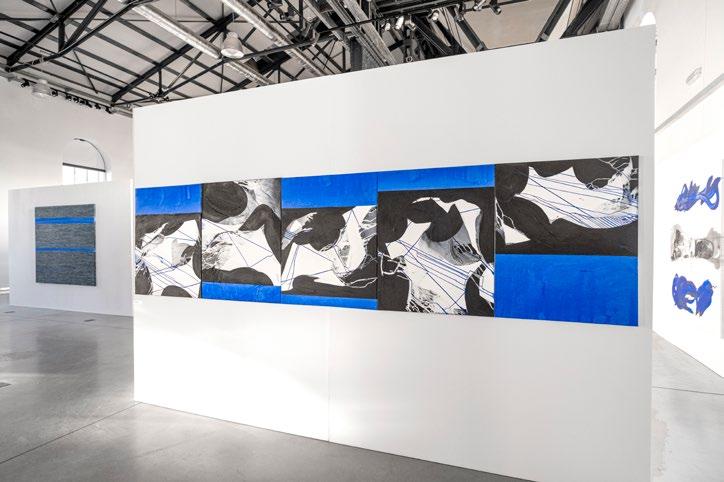
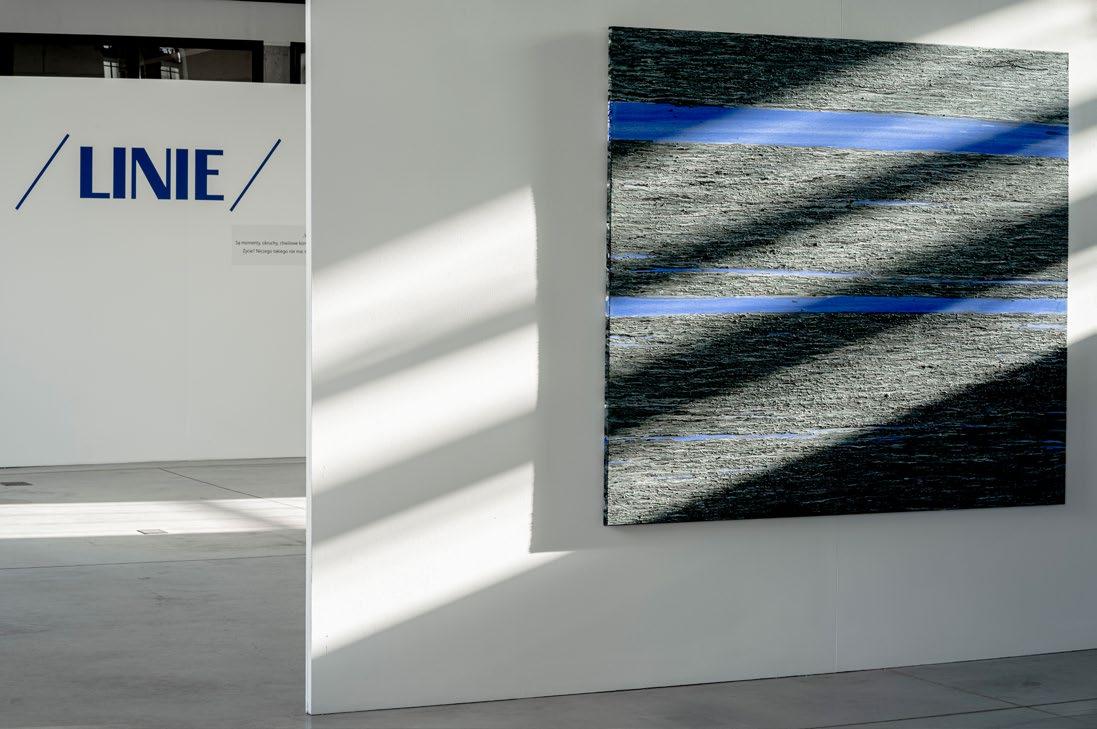
Centrum Nauki, Kultury i Sztuki Stara Kopalnia w Wałbrzychu \ Stara Kopalnia Centre for Science, Culture and the Arts in Wałbrzych
Z innego rodzaju grą przypadkowością mieliśmy do czynienia w serii Niewysłane listy z Pekinu – tutaj pędzel nie dotykał podobrazia (papieru), ręka z pędzlem wykonywała kaligraficzne ruchy unosząc się nad nim w pewnej odległości. Tekst, słowa, frazy stawały się nieczytelne, odsunięcie dłoni od papieru było rodzajem szyfrowania, którego odbiorcom nie uda się złamać, tekst (to paradoks) jest tutaj widoczny i zarazem ukryty, jest obecny, lecz nie pozwala się odczytać.
A different kind of game of chance was played in the series Unsent Letters from Beijing – here the brush did not touch the support (paper), the hand with the brush made calligraphic movements hovering over it at a certain distance. The text, words, phrases became illegible, moving her hand away from the paper was a kind of encryption that the recipients would not be able to break, the text (this is a paradox) is here visible and at the same time hidden, it is present but does not allow itself to be read.
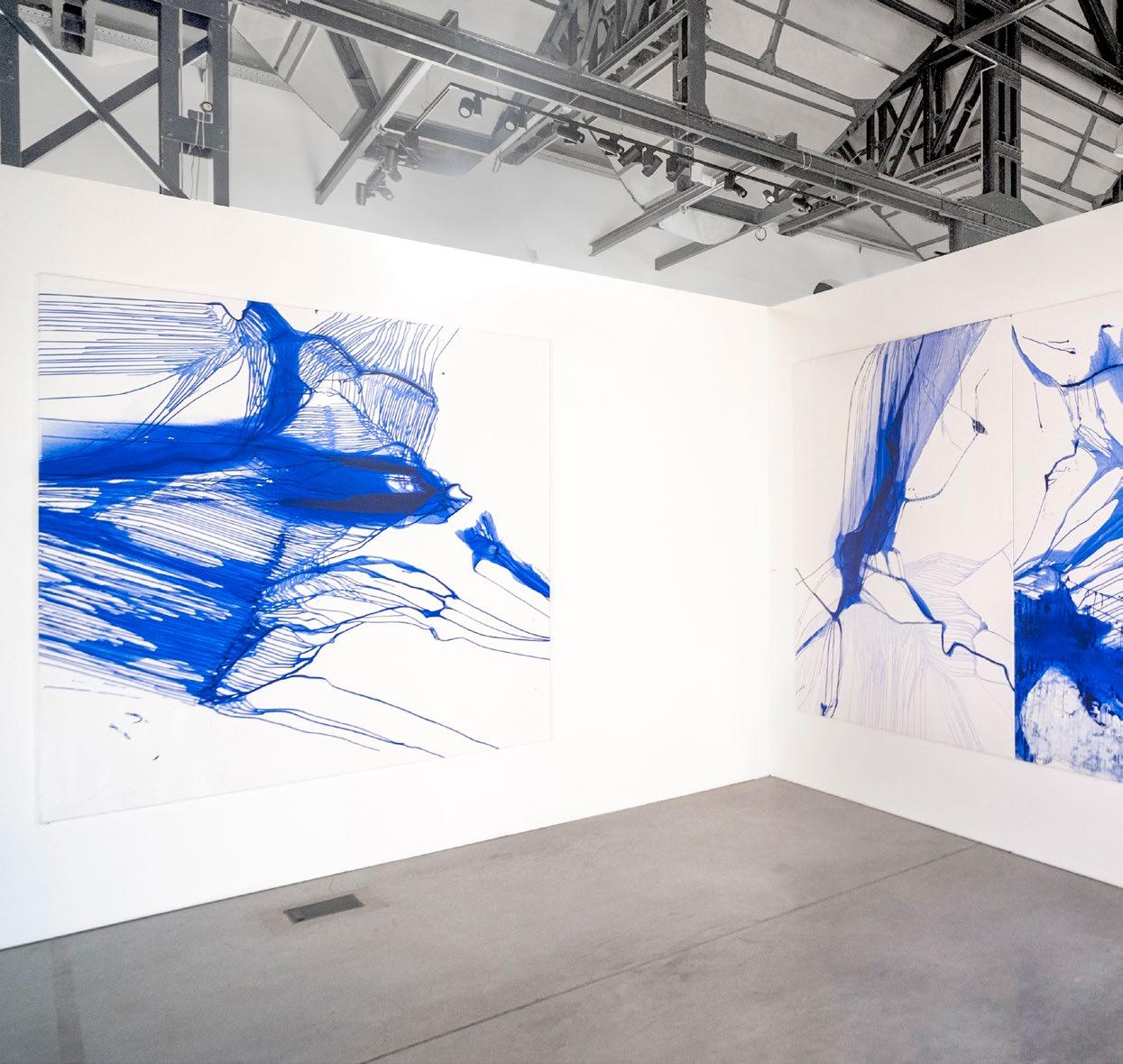
Science, Culture and the Arts in Wałbrzych
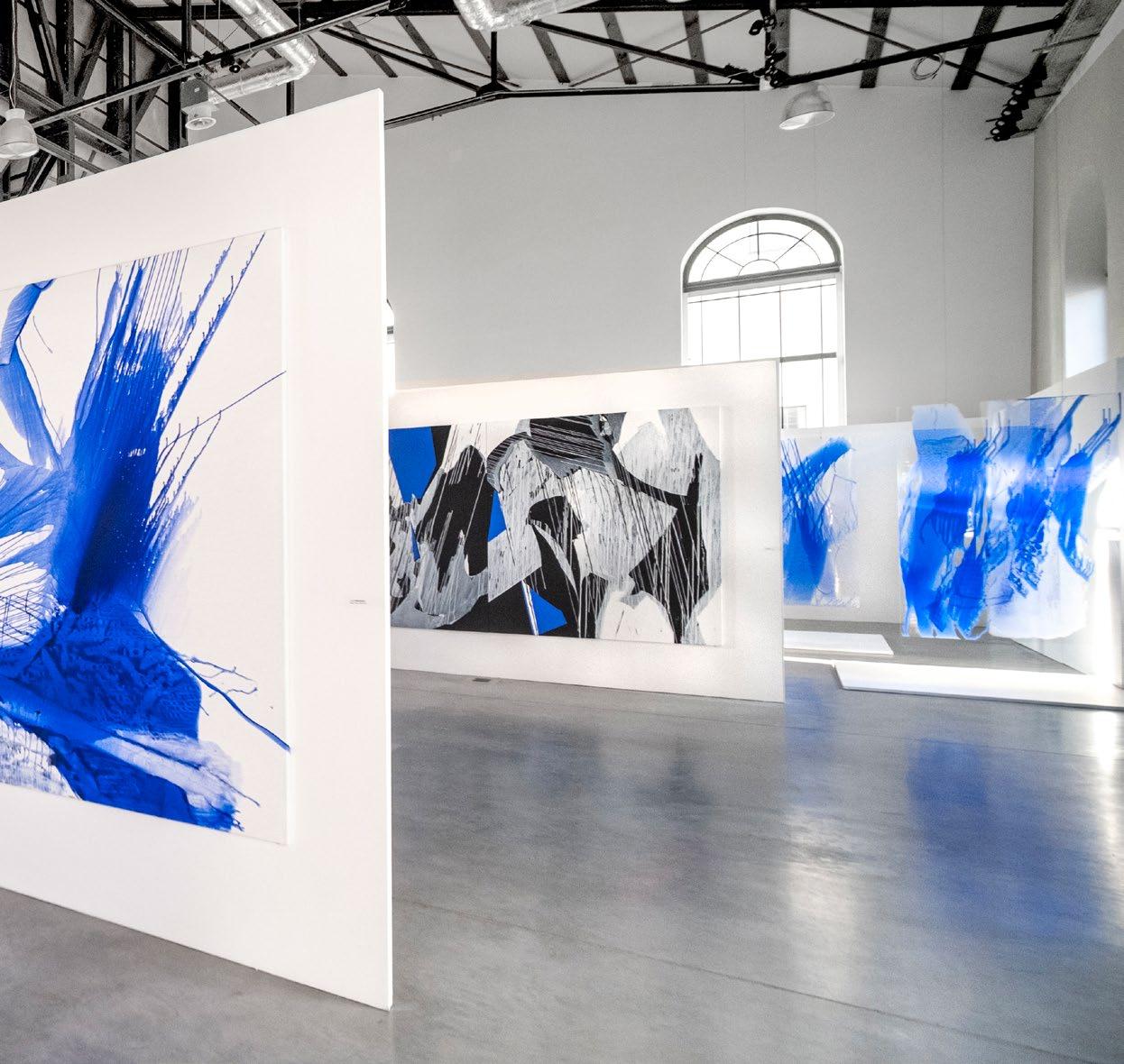
(...) momenty dekoncentracji i ponownej uważności będą odsłaniały istotę tego malarskiego eseju o błękicie, czasie i przestrzeni
(...) moments of distraction and renewed attentiveness that will reveal the essence of this painterly essay on blue, time and space
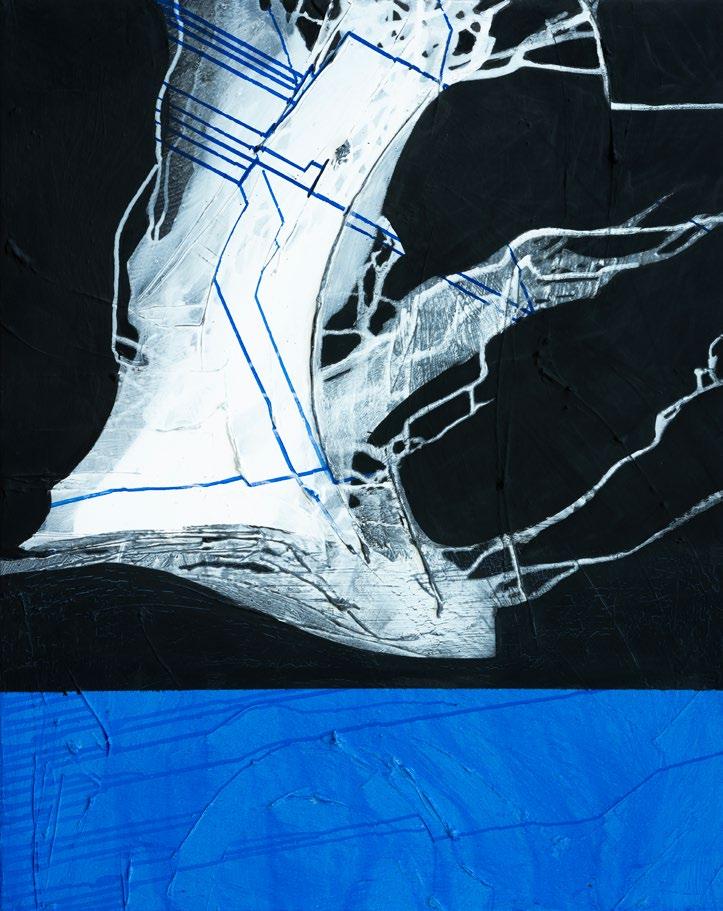
Seria Błękitna Linia \ Blue Line Series \ 2022
olej na płótnie \ oil on canvas \ 100 × 80 cm
→ Linie \ The Lines \ 2023
Centrum Nauki, Kultury i Sztuki Stara Kopalnia w Wałbrzychu \ Stara Kopalnia Centre for Science, Culture and the Arts in Wałbrzych
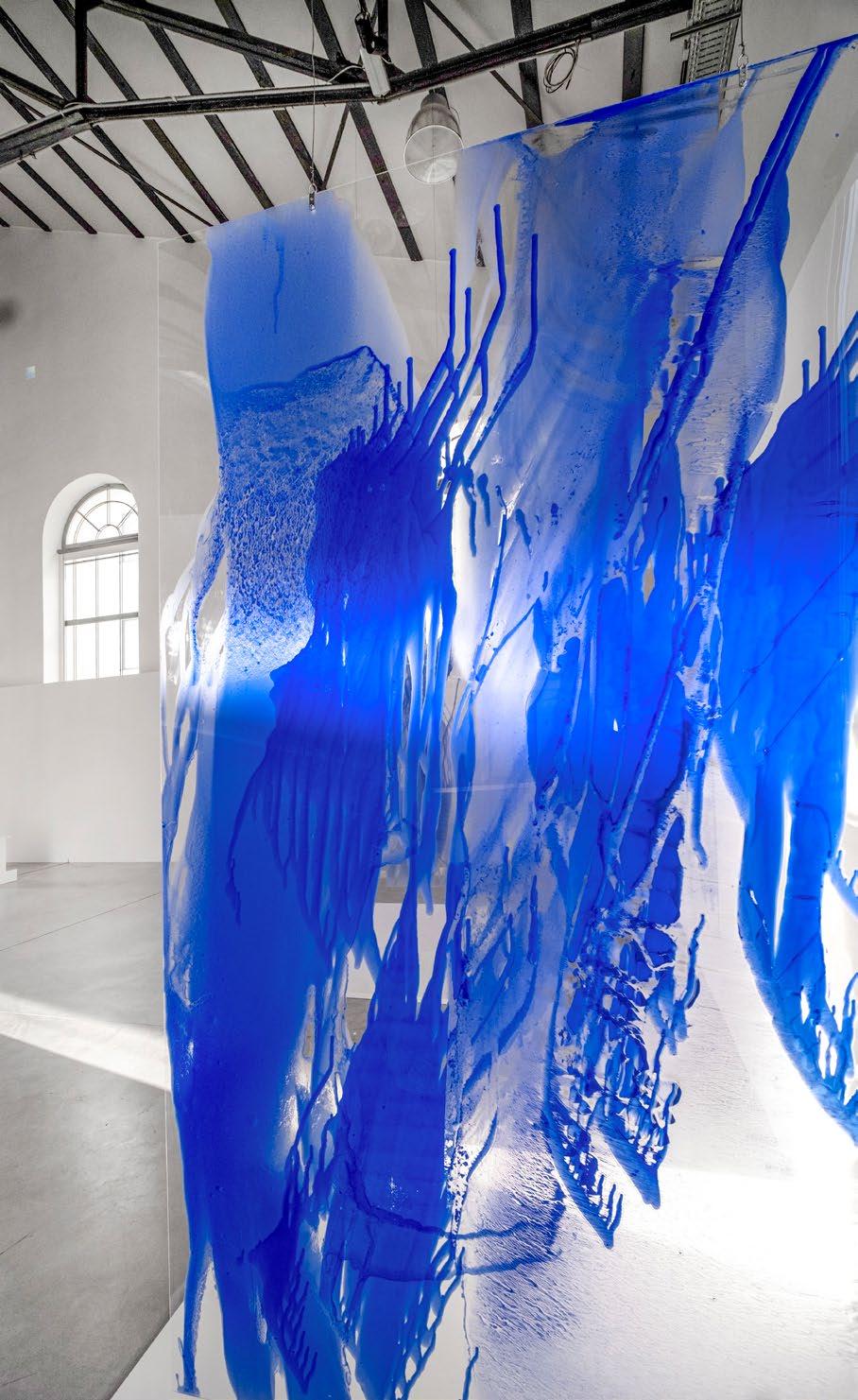
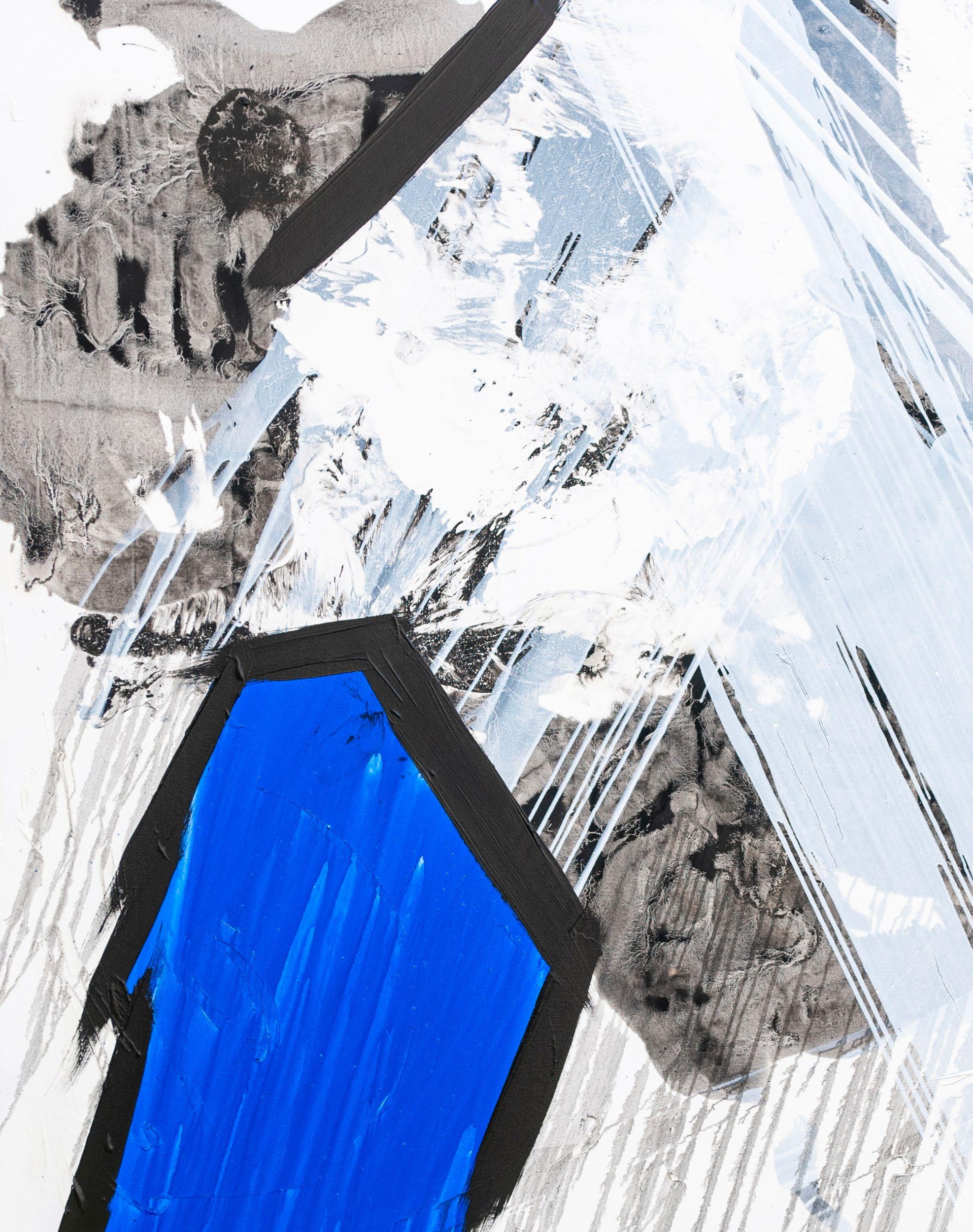

Topografie z Błękitną Linią mają odmienny charakter, rządzą nimi inne reguły. W serii tej na malarski frottage, czyli na odciśnięte na płótnie monochromatyczne struktury (czernie, szarości, biele) artystka nakłada kolejne warstwy, np. w postaci kilku cienkich, błękitnych linii, które wydają się przynależeć do innego porządku. Plamy szarości są nieregularne, mają w sobie coś organicznego i naturalnego, natomiast błękitne linie przywołują matematyczny ład. No i wreszcie pojawia się tu jeszcze jedna warstwa, czyli błękit, który – naniesiony szerszym pędzlem – wygląda jak splątana lina lub poddane destrukcji litery nieznanego pisma. Nawiasem mówiąc, część obrazów w tej serii rozegrana jest tylko w błękitach, wtedy farba nie tylko jest odciskana na płótnie lub nanoszona pędzlem, lecz również rozlewa się po nim tworząc nieregularne nacieki.
Topographies with the Blue Line have a different character and are governed by different rules. In this series on painterly frottage, i.e. on monochrome structures (blacks, greys, whites) imprinted on the canvas, the artist superimposed successive layers, for example in the form of a few thin blue lines, which seem to belong to a different order. The grey patches are irregular, with something organic and natural in them, while the blue lines evoke a mathematical order. And finally, there is another layer, the blue, which – applied with a broader brush – looks like a tangled rope or the destroyed letters of an unknown script. Icidentially, some of the paintings in this series are played out only in blue, in which case the paint is not only imprinted on the canvas or applied with a brush, but also spills over it to form irregular infiltrations.
Seria Topografie z błękitną linią \ Topographies with Blue Line Series \ 2024
olej na płótnie \ oil on canvas \ 150 × 160 cm
Wydaje się, że obrazy te są próbą zbudowania malarskiego dialogu z efemerycznymi strukturami błękitu widniejącymi na foliach, które również zawisły w przestrzeni wałbrzyskiej galerii. Obrazy na transparentnym podłożu wchodzą w dialog w dziełami wiszącymi na ścianach. To odbiorca krążący w przestrzeni ekspozycyjnej uruchamia rozmowę obrazów, to jego percepcyjne skupienie, momenty dekoncentracji i ponownej uważności bęzdą odsłaniały istotę tego malarskiego eseju o błękicie, czasie i przestrzeni.
Esej tworzymy wtedy, gdy mamy pytania, lecz nie posiadamy odpowiedzi – zatem tworzymy go (piszemy, fotografujemy, malujemy), by sformułować owe pytania, by pobyć z nimi i spróbować odnaleźć te właściwe, dzięki którym zbliżymy się do nurtującej nas tajemnicy, do nadania właściwego imienia naszym lękom, fascynacjom i obsesjom. Do takiej przestrzeni zaprasza nas artystka.
It seems that these paintings are an attempt to build a painterly dialogue with the ephemeral structures of blue seen on the foils that were also hanging in the Wałbrzych gallery space. The paintings on a transparent surface enter into a dialogue with the works hanging on the walls. It is the viewer circulating in the exhibition space who triggers the conversation of the paintings, it is his or her perceptual focus, moments of distraction and renewed attentiveness that will reveal the essence of this painterly essay on blue, time and space. We create an essay when we have questions but no answers – so we create it (by writing, photographing, painting) in order to formulate these questions, to spend time with them and try to find the right ones, through which we can get closer to the mystery that troubles us, to give a proper name to our fears, fascinations and obsessions. This is the space into which the artist invites us.
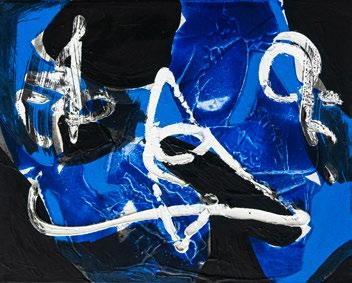
tytułu \ Untitled \ 2024 olej na płótnie \ oil on canvas \ 40 × 50 cm
Seria Blue \ Blue Series \ 2024
olej na płótnie \ acrylic, oil on canvas \ 200 × 170 cm

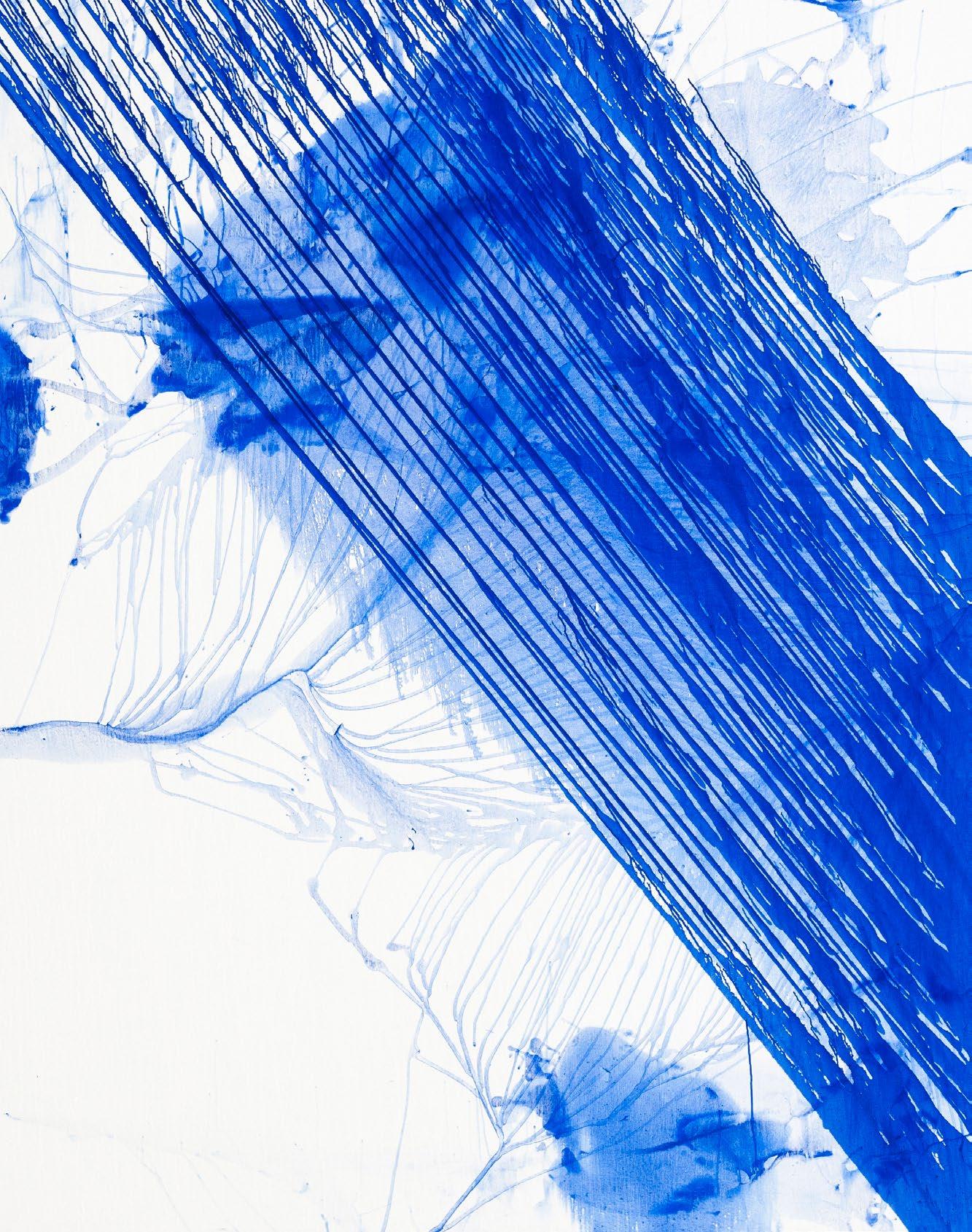
1986 \ URSZULA WILK
Dyplom w pracowni
prof. Zbigniewa Karpińskiego \ Akademia Sztuk Pięknych Wrocław
nagrody i stypendia
1987 \
\
\
\
\ 2020 \
2020 \
Stypendium Ministra Kultury i Sztuki
Stypendium Ministra Kultury i Sztuki Nagroda Główna \ I Pokonkursowa Wystawa Malarstwa im. Eugeniusza Gepperta \ Wrocław
Stypendium The PollockKrasner Foundation \ New York \ USA
Stypendium Ministra Kultury i Dziedzictwa Narodowego
Nagroda roku 2013 \ ZPAP \ okręg wrocławski
Nagroda Główna Międzynarodowe Biennale Akwareli \ Shenzhen \ Chiny
Stypendium Ministra Kultury i Dziedzictwa
Narodowego
Stypendium Prezydenta Wrocławia
prace w zbiorach
Muzeum Miejskie Wrocławia
Shangyuan Art Muzeum \ Pekin \ Chiny
Zbiory Zachęty Dolnośląskiej
Louhu Art Muzeum \ Shenzhen \ Chiny
Dafen Art Museum \ Shenzhen \ Chiny
Fundacja Stefana Gierowskiego
Master of Arts Degree in Painting prof. Zbigniew Karpiński’s atelier \ Academy of Fine Arts in Wroclaw
awards and grants
Grant from the Minister of Art and Culture
Grant from the Minister of Art and Culture 1st Prize \ the Eugeniusz Geppert contest exhibitions \ Wrocław
Grant the PollockKrasner Foundation \ New York \ USA
Grant from the Minister of Art and Heritage \ Poland
1st Prize – the best exhibition in 2013 \ Polish Association of Artists in Wroclaw
Grand Prix – International Watercolour
Biennale Shenzhen \ China
Grant from the Minister of Art and Heritage
Grant from the city mayor of Wrocław
works found in collections
Wrocław City Museum
Shang Youan Art Museum \ Beijing \ China
Lower Silesia Zachęta
Shenzhen Louhu Art Museum \ China
Dafen Art Museum \ Shenshen \ China
Stefan Gierowski Foundation
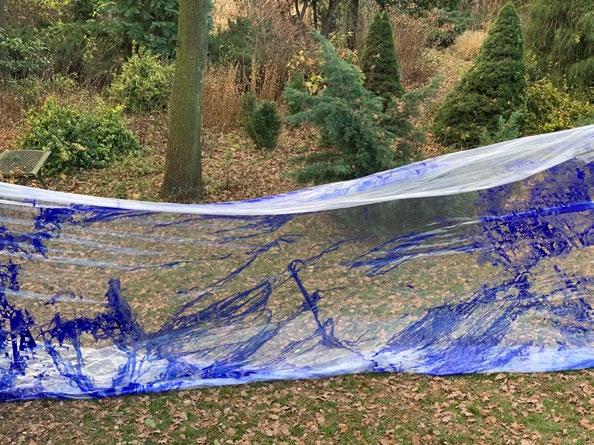

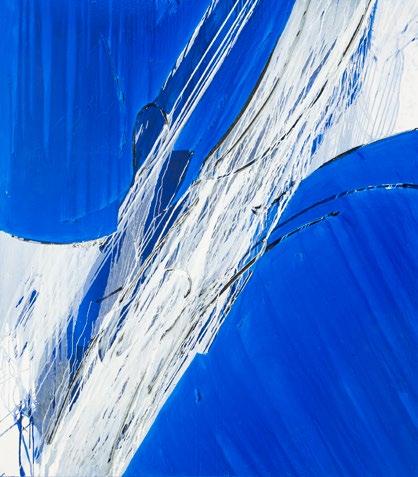
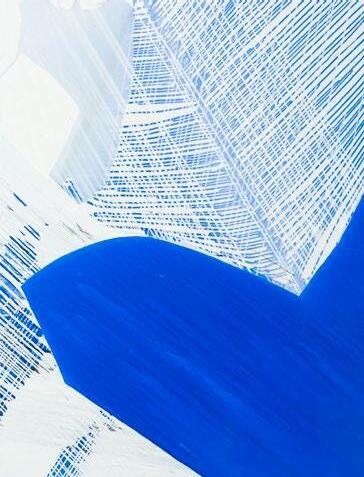
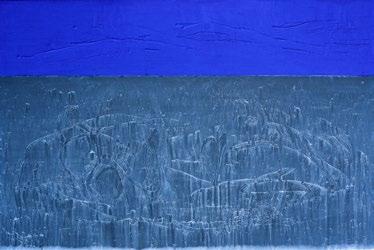
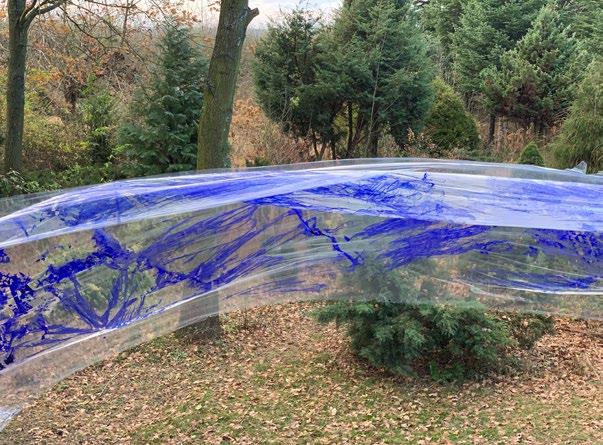
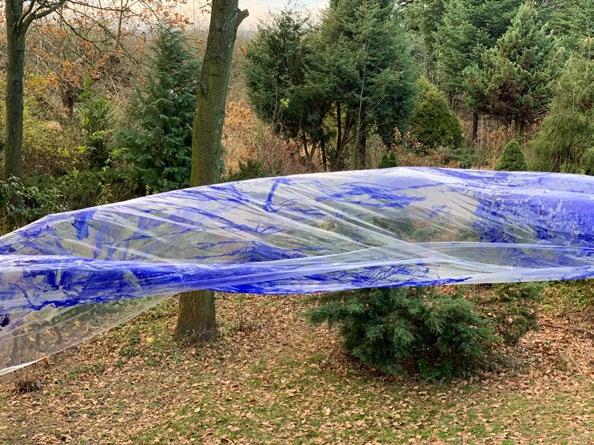
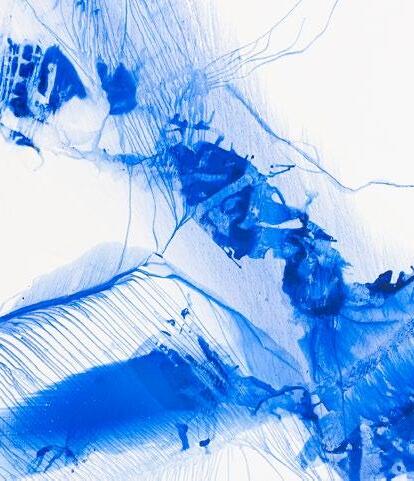
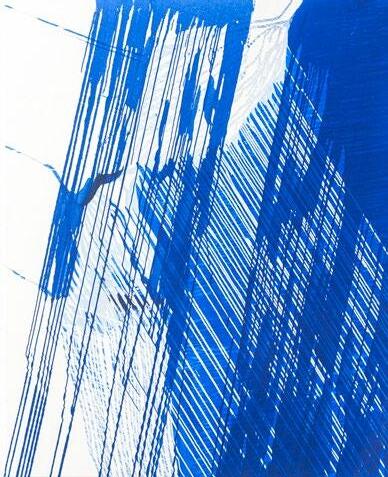
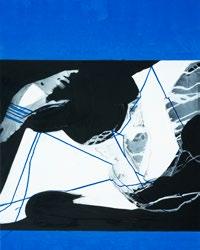

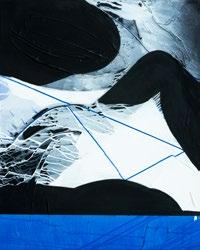
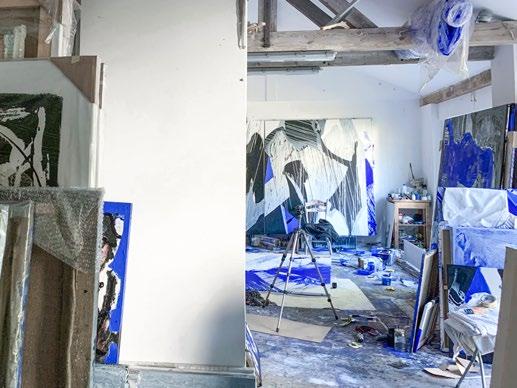

Zadanie współfinansowane ze środków budżetu
Samorządu Województwa Dolnośląskiego
The task co financed by the budget of the Lower Silesian Voivodeship Government

Zadanie zrealizowane w ramach projektu
Bluemetrie – śłady i szepty – katalog
T he task completed as part of the project
Bluemetrie – Traces and Whispers – Catalog
Tekst:
Marek Śnieciński
Projekt graficzny:
Magdalena Jaskułowska, Łukasz Kujawski
Fotografie:
Alicja Kielan: str. 4–5, 48–49;
Mirosław Emil Koch: str. 7, 8–9, 12–13, 14; Irmina Rusicka i Kasper Lecnim: str. 16, 34; Łukasz Kujawski: str. 40, 41, 47, 58–59, 60–61, 63, 70, 71.
Pozostałe fotografie:
Urszula Wilk, Eugeniusz Minciel
Reprodukcje:
Łukasz Kujawski
Tłumaczenia:
Tomasz Bauer
Konsultacja:
Irmina Rusicka
Tekst „ Bluemetrie c.d. – nowe prace Urszuli Wilk” ukazał się w Kwartalniku Instytutu
Historii Sztuki Uniwersytetu Wrocławskiego
„Quart” nr 4 (62)/2021
Text: Marek Śnieciński
Graphic design:
Magdalena Jaskułowska, Łukasz Kujawski
Photographs:
Alicja Kielan: p. 4–5, 48–49; Mirosław Emil Koch: p. 7, 8–9, 12–13, 14; Irmina Rusicka and Kasper Lecnim: p. 16, 34; Łukasz Kujawski: p. 40, 41, 47, 58–59, 60–61, 63, 70, 71.
Other photographs:
Urszula Wilk, Eugeniusz Minciel
Reproductions:
Łukasz Kujawski
Translations: Tomasz Bauer
Consultation: Irmina Rusicka
The text "Bluemetries cont. – new works by Urszula Wilk" was published in the Quarterly of the Institute of Art History of the University of Wrocław "Quart" No. 4 (62)/2021
Pomoc w realizacji wystawy w Luksemburgu oraz poligraficznej wersji katalogu:
Support in the implementation of the exhibition in Luxembourg and the printing version of the catalog:
Projekt dofinansowany przez Wydział Kultury Urzędu Miejskiego Wrocławia
Powiat Strzeliński jako samorząd jest niezwykle dumny, że w tak niewielkiej społeczności mogą rozwijać się talenty artystyczne na najwyższym poziomie. Z radością wspieramy wydanie katalogu wystawy malarskiej –Urszuli Wilk, której prace będą prezentowane szerokiej publiczności w Europie. Praca nad przygotowaniem tej wyjątkowej wystawy trwała ponad rok, a w katalogu znajdą się dzieła z ostatnich kilku lat, ukazujące bogactwo i różnorodność twórczości artystki z Powiatu Strzelińskiego.
As a local authority, Strzelin County is extremely proud that artistic talents of the highest level can develop in such a small community. We are happy to support the publication of the catalogue of the painting exhibition of Urszula Wilk, whose works will be presented to a wide audience throughout Europe. More than a year's effort went into the preparation of this unique exhibition, and the catalogue will feature works from the last few years, showing the richness and diversity of the Strzelin artist's oeuvre.
The project is co finance d by the Department of Culture of the Wrocław City Hall

Powiat Strzeliński Strzelin District Council

Gmina Wiązów Municipality of Wiązów
Soroptimist International of Poland
Klub „Wratislavia”

Jest to dla nas nie tylko powód do dumy, ale również doskonała okazja, aby promować nasz region jako miejsce, gdzie kultura i sztuka mają szczególne znaczenie. Powiat Strzeliński, choć niewielki, może poszczycić się licznymi talentami, które przyczyniają się do rozwoju kulturalnego naszej społeczności. Wspieranie twórczości artystycznej jest jednym z priorytetów naszego samorządu, ponieważ wierzymy, że sztuka odgrywa kluczową rolę w rozwoju społecznym i osobistym.
Starosta Strzelińska
Magdalena Krupa
This is not only a source of pride for us, but also an excellent opportunity to promote our region as a place where culture and the arts are of particular importance. Strzelin County, although not large, boasts numerous talents who contribute to the cultural development of our community. Supporting artistic creativity is one of the priorities of our local government, as we believe that art plays key role in social and personal growth.
District Governor
Magdalena Krupa
Agnes i Remi Berchen – thank you! Ula
